-
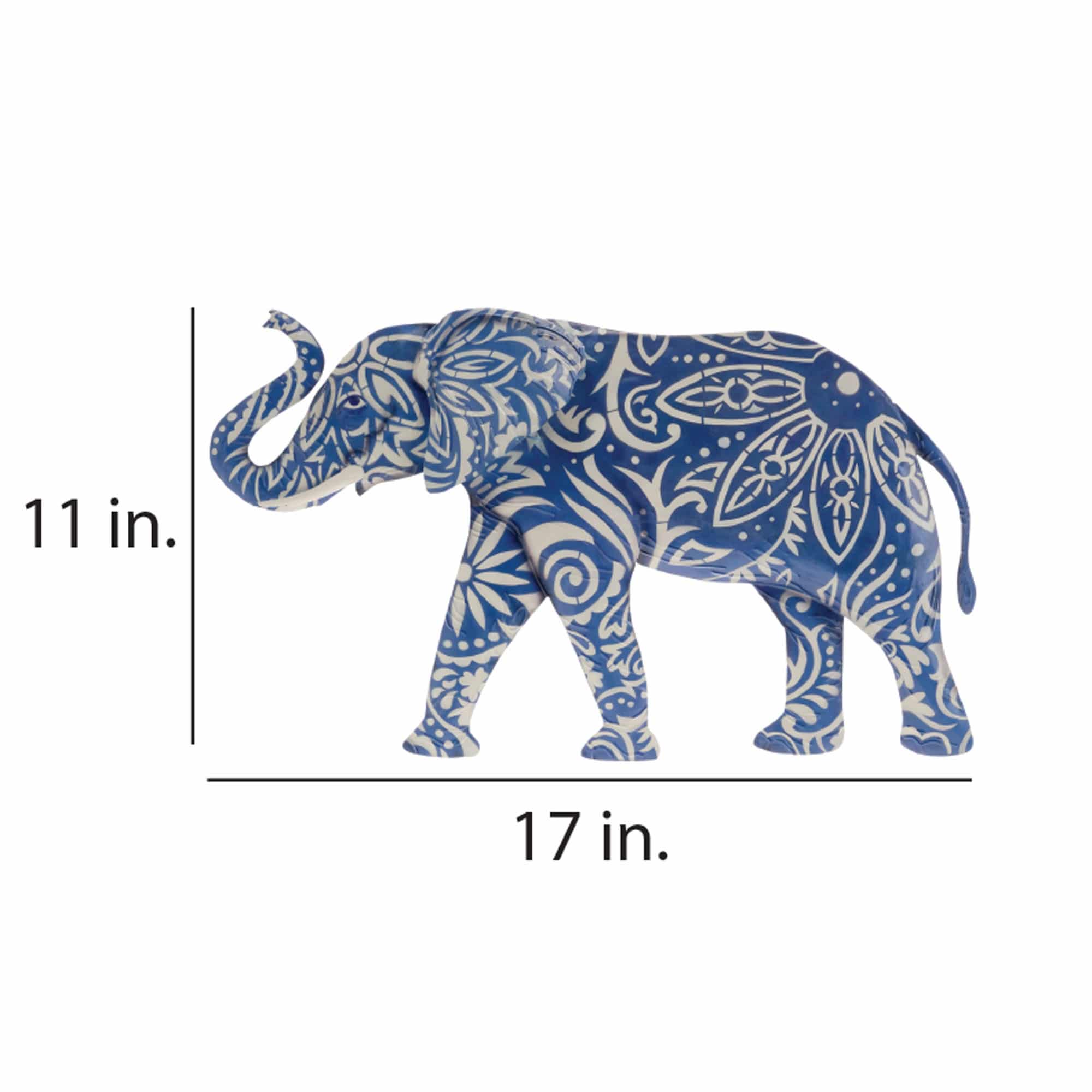
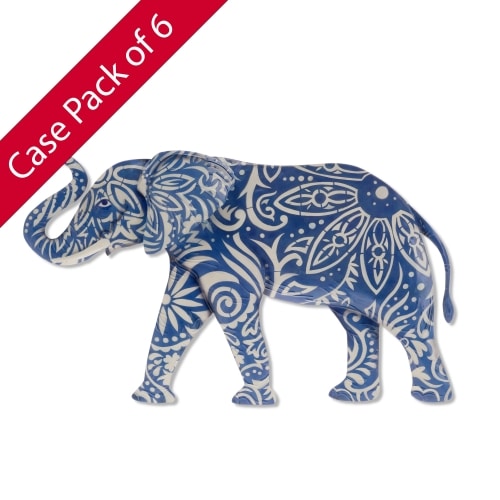 Case of 6 According to feng shui, an elephant with its trunk raised will shower good luck to those around it. It is a symbol for intelligence, curiosity, kindness and strength. The basic shape of this handcrafted metal elephant has its powerful trunk raised due to the importance of the symbolism. Furthermore, the artisan hand-paints the body in a colorful pattern influenced by designs from different Eastern cultures. Placing such a symbol near a door is said to welcome beneficial energy into that space. The basic frame of the is created using tin, which is powder coated with a black finish. The frame is reinforced using tin wire along the inner edge. Capiz is an oyster shell and the primary purpose of the oyster is as a source of food. However, the by-product, the shell, can be used for decoration. Due to it being a natural material, the natural colors of the capiz come through as tans and browns underneath the paint. The shell is then painted the bold colors you see. The entire front facing piece is carefully hand-painted.
Case of 6 According to feng shui, an elephant with its trunk raised will shower good luck to those around it. It is a symbol for intelligence, curiosity, kindness and strength. The basic shape of this handcrafted metal elephant has its powerful trunk raised due to the importance of the symbolism. Furthermore, the artisan hand-paints the body in a colorful pattern influenced by designs from different Eastern cultures. Placing such a symbol near a door is said to welcome beneficial energy into that space. The basic frame of the is created using tin, which is powder coated with a black finish. The frame is reinforced using tin wire along the inner edge. Capiz is an oyster shell and the primary purpose of the oyster is as a source of food. However, the by-product, the shell, can be used for decoration. Due to it being a natural material, the natural colors of the capiz come through as tans and browns underneath the paint. The shell is then painted the bold colors you see. The entire front facing piece is carefully hand-painted. -
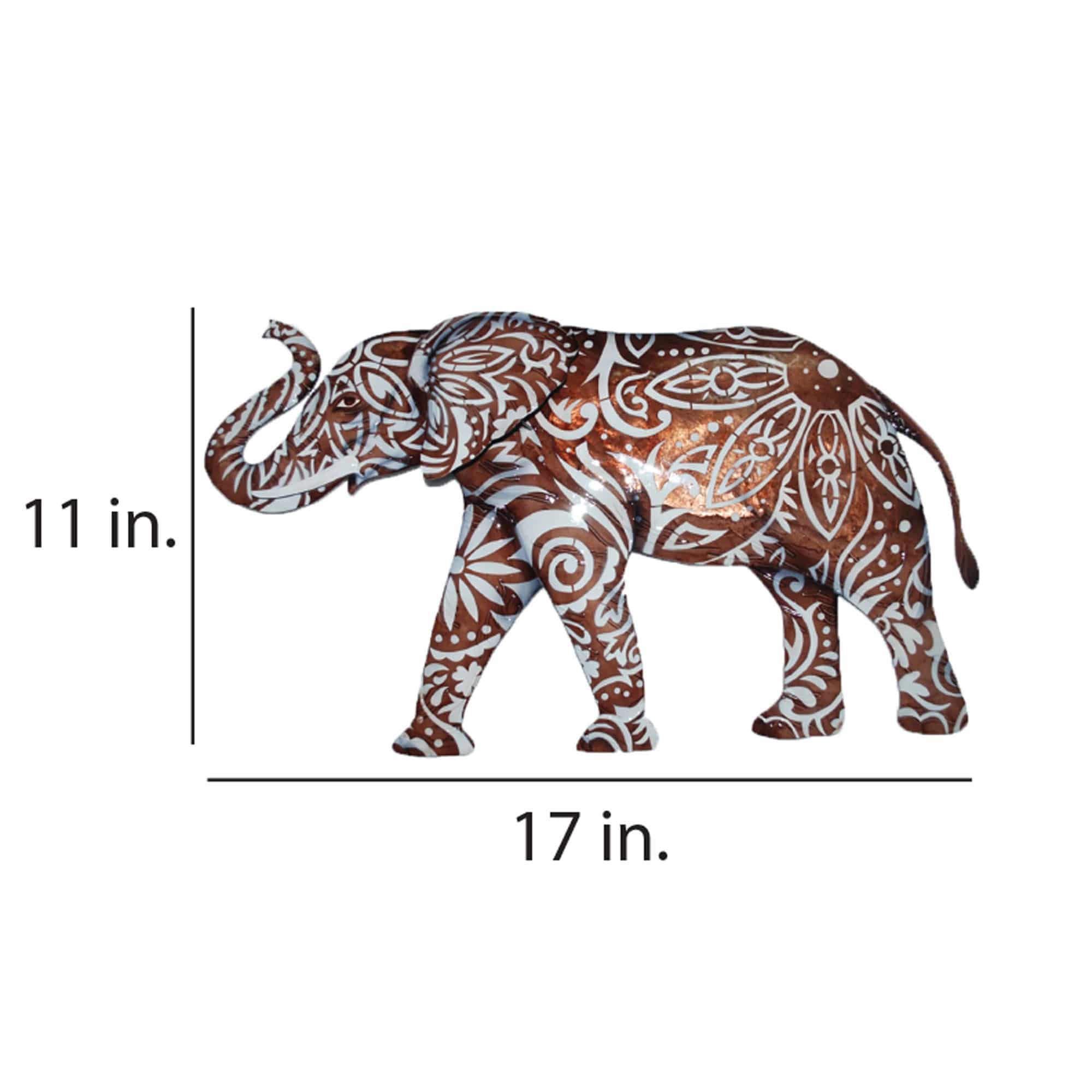
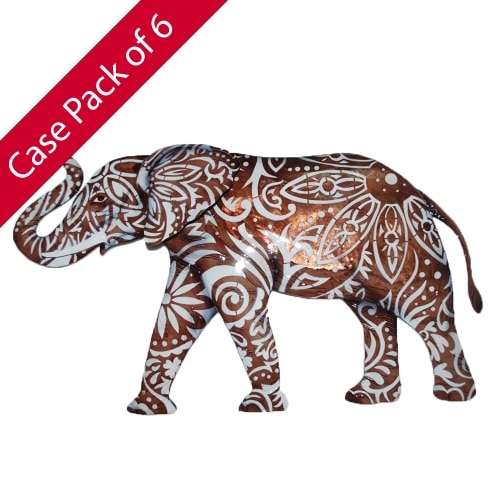 Case of 6 According to feng shui, an elephant with its trunk raised will shower good luck to those around it. It is a symbol for intelligence, curiosity, kindness and strength. The basic shape of this handcrafted metal elephant has its powerful trunk raised due to the importance of the symbolism. Furthermore, the artisan hand-paints the body in a colorful pattern influenced by designs from different Eastern cultures. Placing such a symbol near a door is said to welcome beneficial energy into that space. The basic frame of the is created using tin, which is powder coated with a black finish. The frame is reinforced using tin wire along the inner edge. Capiz is an oyster shell and the primary purpose of the oyster is as a source of food. However, the by-product, the shell, can be used for decoration. Due to it being a natural material, the natural colors of the capiz come through as tans and browns underneath the paint. The shell is then painted the bold colors you see. The entire front facing piece is carefully hand-painted.
Case of 6 According to feng shui, an elephant with its trunk raised will shower good luck to those around it. It is a symbol for intelligence, curiosity, kindness and strength. The basic shape of this handcrafted metal elephant has its powerful trunk raised due to the importance of the symbolism. Furthermore, the artisan hand-paints the body in a colorful pattern influenced by designs from different Eastern cultures. Placing such a symbol near a door is said to welcome beneficial energy into that space. The basic frame of the is created using tin, which is powder coated with a black finish. The frame is reinforced using tin wire along the inner edge. Capiz is an oyster shell and the primary purpose of the oyster is as a source of food. However, the by-product, the shell, can be used for decoration. Due to it being a natural material, the natural colors of the capiz come through as tans and browns underneath the paint. The shell is then painted the bold colors you see. The entire front facing piece is carefully hand-painted. -
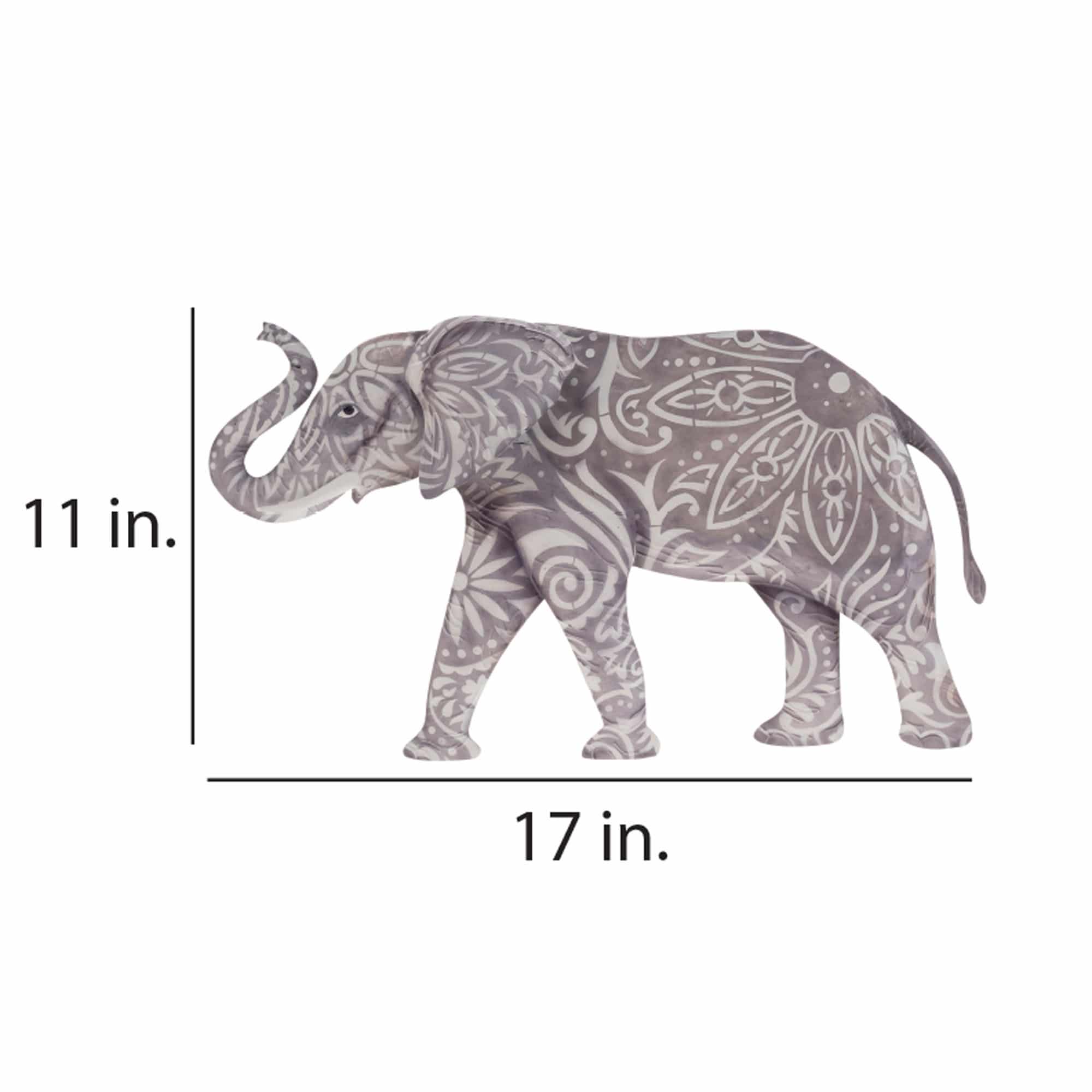
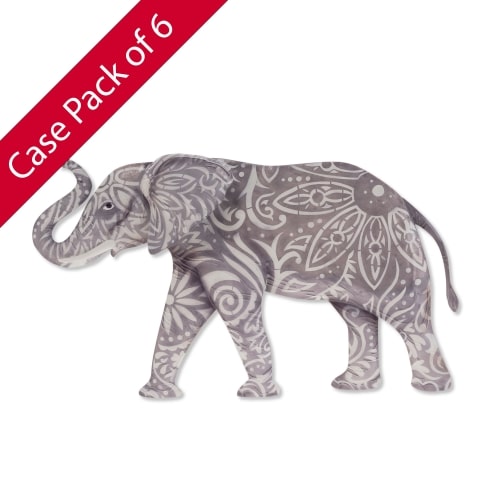 Case of 6 According to feng shui, an elephant with its trunk raised will shower good luck to those around it. It is a symbol for intelligence, curiosity, kindness and strength. The basic shape of this handcrafted metal elephant has its powerful trunk raised due to the importance of the symbolism. Furthermore, the artisan hand-paints the body in a colorful pattern influenced by designs from different Eastern cultures. Placing such a symbol near a door is said to welcome beneficial energy into that space. The basic frame of the is created using tin, which is powder coated with a black finish. The frame is reinforced using tin wire along the inner edge. Capiz is an oyster shell and the primary purpose of the oyster is as a source of food. However, the by-product, the shell, can be used for decoration. Due to it being a natural material, the natural colors of the capiz come through as tans and browns underneath the paint. The shell is then painted the bold colors you see. The entire front facing piece is carefully hand-painted.
Case of 6 According to feng shui, an elephant with its trunk raised will shower good luck to those around it. It is a symbol for intelligence, curiosity, kindness and strength. The basic shape of this handcrafted metal elephant has its powerful trunk raised due to the importance of the symbolism. Furthermore, the artisan hand-paints the body in a colorful pattern influenced by designs from different Eastern cultures. Placing such a symbol near a door is said to welcome beneficial energy into that space. The basic frame of the is created using tin, which is powder coated with a black finish. The frame is reinforced using tin wire along the inner edge. Capiz is an oyster shell and the primary purpose of the oyster is as a source of food. However, the by-product, the shell, can be used for decoration. Due to it being a natural material, the natural colors of the capiz come through as tans and browns underneath the paint. The shell is then painted the bold colors you see. The entire front facing piece is carefully hand-painted. -
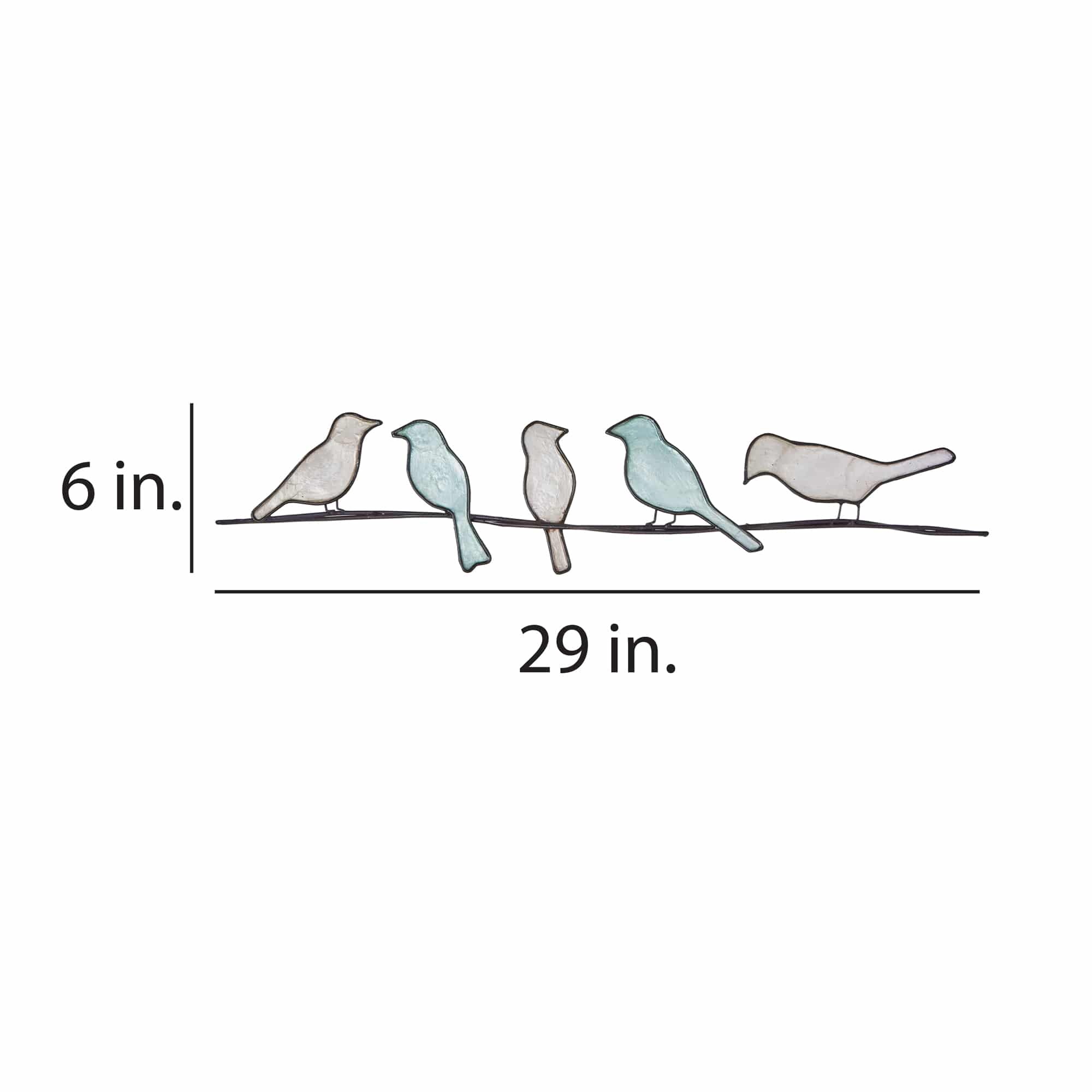
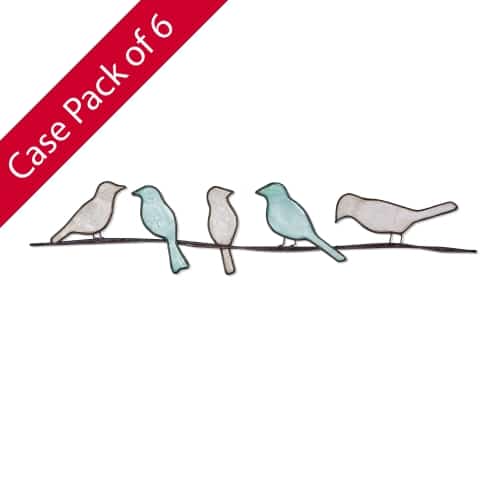 Case of 6 An old parable states that five birds were resting on a wire. Two decided to fly south. How many were birds are left? One's initial answer may be three, however, the answer is still five. The moral of the fable is actions are more important than intention; a kind reminder that a truer picture of one's character is drawn by actions. The artisan captures this parable by lining up five birds socializing on a wire. The basic frame of this piece is created using tin, which is powder coated with a black finish. The frame is reinforced using tin wire along the inner edge. The front of the body is adorned with capiz. Capiz is an oyster shell and the primary purpose of the oyster is as a source of food. However, the by-product, the shell, can be used for decoration. Due to it being a natural material, the natural colors of the capiz may come through as tans and browns underneath the hand-painted surface.
Case of 6 An old parable states that five birds were resting on a wire. Two decided to fly south. How many were birds are left? One's initial answer may be three, however, the answer is still five. The moral of the fable is actions are more important than intention; a kind reminder that a truer picture of one's character is drawn by actions. The artisan captures this parable by lining up five birds socializing on a wire. The basic frame of this piece is created using tin, which is powder coated with a black finish. The frame is reinforced using tin wire along the inner edge. The front of the body is adorned with capiz. Capiz is an oyster shell and the primary purpose of the oyster is as a source of food. However, the by-product, the shell, can be used for decoration. Due to it being a natural material, the natural colors of the capiz may come through as tans and browns underneath the hand-painted surface. -
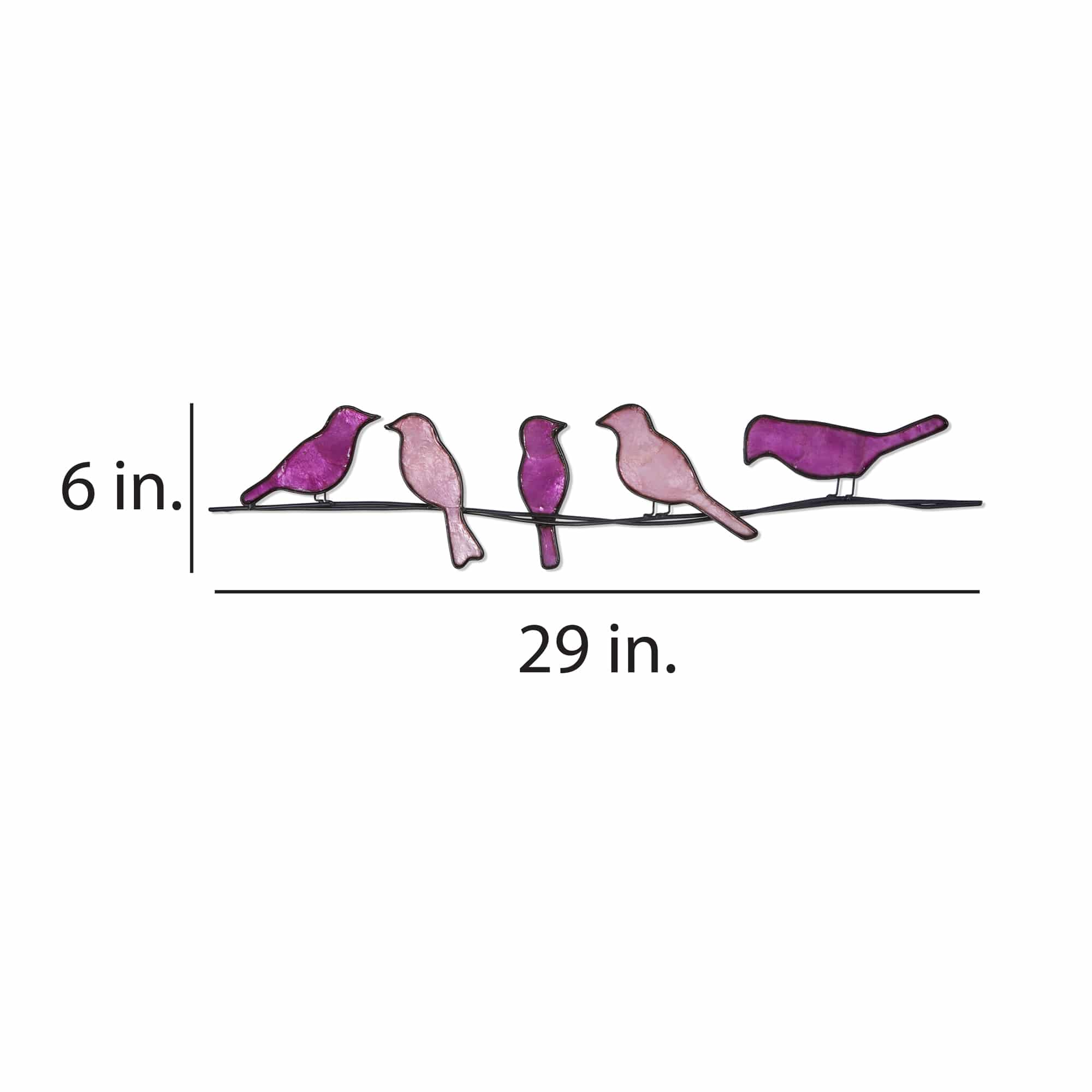
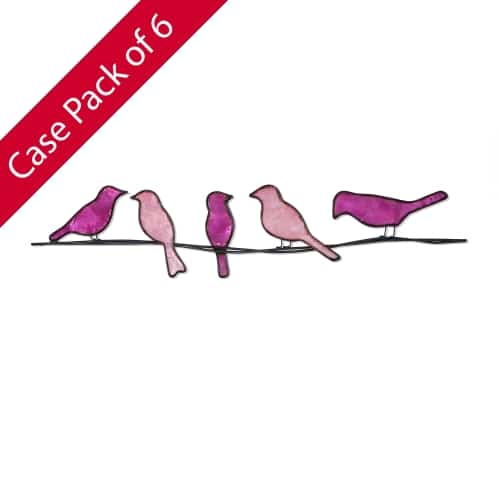 Case of 6 An old parable states that five birds were resting on a wire. Two decided to fly south. How many were birds are left? One's initial answer may be three, however, the answer is still five. The moral of the fable is actions are more important than intention; a kind reminder that a truer picture of one's character is drawn by actions. The artisan captures this parable by lining up five birds socializing on a wire. The basic frame of this piece is created using tin, which is powder coated with a black finish. The frame is reinforced using tin wire along the inner edge. The front of the body is adorned with capiz. Capiz is an oyster shell and the primary purpose of the oyster is as a source of food. However, the by-product, the shell, can be used for decoration. Due to it being a natural material, the natural colors of the capiz may come through as tans and browns underneath the hand-painted surface.
Case of 6 An old parable states that five birds were resting on a wire. Two decided to fly south. How many were birds are left? One's initial answer may be three, however, the answer is still five. The moral of the fable is actions are more important than intention; a kind reminder that a truer picture of one's character is drawn by actions. The artisan captures this parable by lining up five birds socializing on a wire. The basic frame of this piece is created using tin, which is powder coated with a black finish. The frame is reinforced using tin wire along the inner edge. The front of the body is adorned with capiz. Capiz is an oyster shell and the primary purpose of the oyster is as a source of food. However, the by-product, the shell, can be used for decoration. Due to it being a natural material, the natural colors of the capiz may come through as tans and browns underneath the hand-painted surface. -
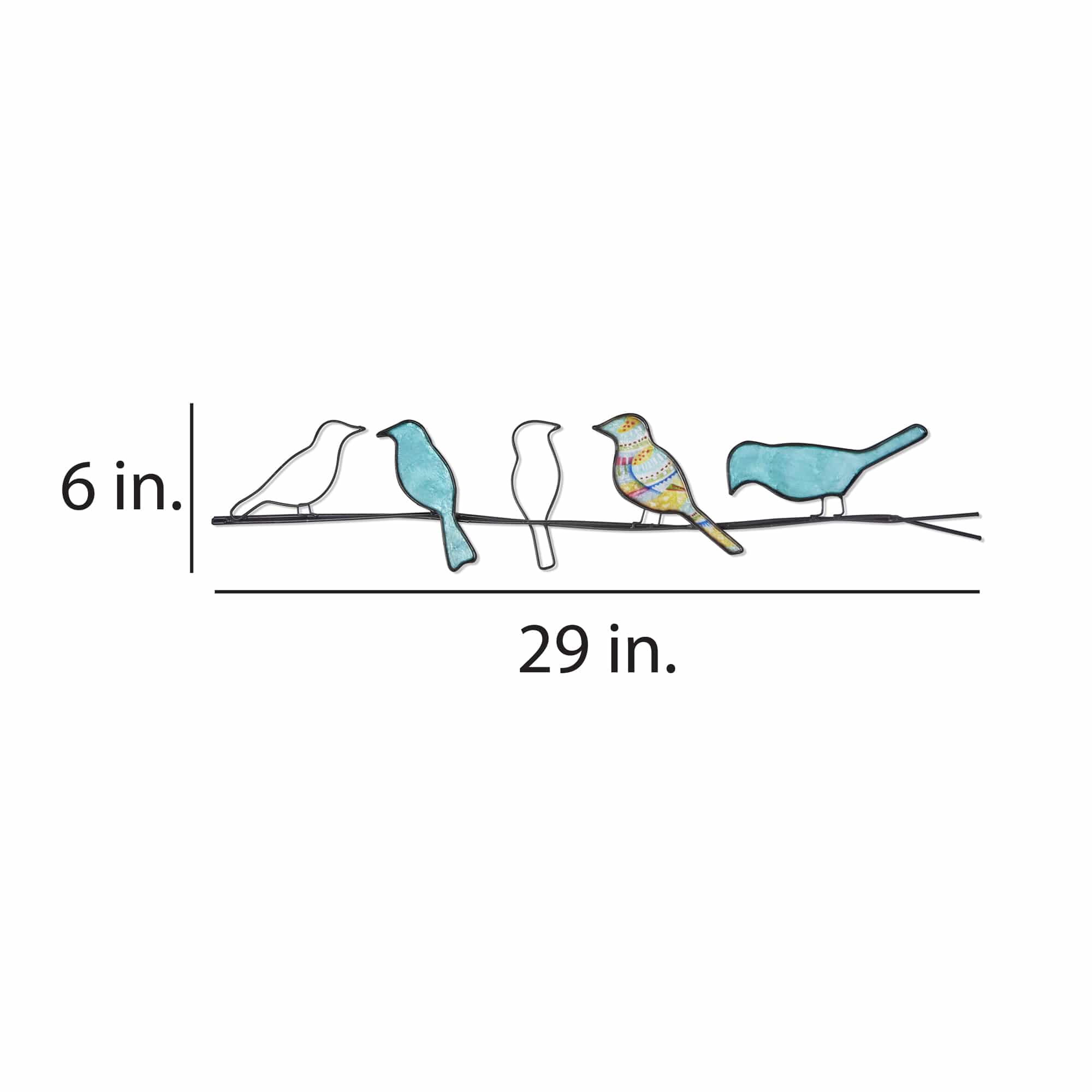
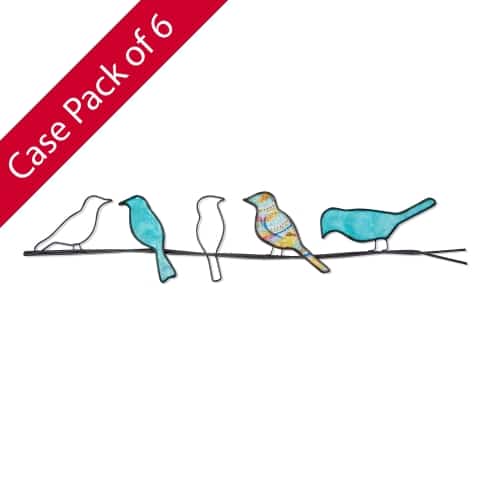 Case of 6 An old parable states that five birds were resting on a wire. Two decided to fly south. How many were birds are left? One's initial answer may be three, however, the answer is still five. The moral of the fable is actions are more important than intention; a kind reminder that a truer picture of one's character is drawn by actions. The artisan captures this parable by lining up five birds socializing on a wire. The basic frame of this piece is created using tin, which is powder coated with a black finish. The frame is reinforced using tin wire along the inner edge. The front of the body is adorned with capiz. Capiz is an oyster shell and the primary purpose of the oyster is as a source of food. However, the by-product, the shell, can be used for decoration. Due to it being a natural material, the natural colors of the capiz may come through as tans and browns underneath the hand-painted surface.
Case of 6 An old parable states that five birds were resting on a wire. Two decided to fly south. How many were birds are left? One's initial answer may be three, however, the answer is still five. The moral of the fable is actions are more important than intention; a kind reminder that a truer picture of one's character is drawn by actions. The artisan captures this parable by lining up five birds socializing on a wire. The basic frame of this piece is created using tin, which is powder coated with a black finish. The frame is reinforced using tin wire along the inner edge. The front of the body is adorned with capiz. Capiz is an oyster shell and the primary purpose of the oyster is as a source of food. However, the by-product, the shell, can be used for decoration. Due to it being a natural material, the natural colors of the capiz may come through as tans and browns underneath the hand-painted surface. -

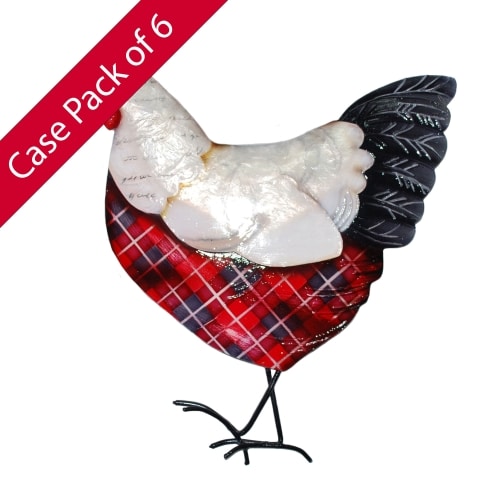 Case of 6 Farm animals are a common theme in the modern farmhouse design with plaid often used as an accent. Featuring modern farmhouse themes, this chicken is both classic and fun in the way the basic colors are portrayed on the familiar design shape. The mother of pearl oyster shell gives the piece an aged patina Modern farmhouse themes also about bringing the old back to new. As an added detail, the neck of the chicken features an excerpt of an old handwritten letter. The basic frame of this piece is created using tin, which is powder coated with a black finish. The frame is reinforced using tin wire along the inner edge. The front of the body is adorned with capiz. Capiz is an oyster shell and the primary purpose of the oyster is as a source of food. However, the by-product, the shell, can be used for decoration. Due to it being a natural material, the natural colors of the capiz may come through as tans and browns underneath the hand-painted surface.
Case of 6 Farm animals are a common theme in the modern farmhouse design with plaid often used as an accent. Featuring modern farmhouse themes, this chicken is both classic and fun in the way the basic colors are portrayed on the familiar design shape. The mother of pearl oyster shell gives the piece an aged patina Modern farmhouse themes also about bringing the old back to new. As an added detail, the neck of the chicken features an excerpt of an old handwritten letter. The basic frame of this piece is created using tin, which is powder coated with a black finish. The frame is reinforced using tin wire along the inner edge. The front of the body is adorned with capiz. Capiz is an oyster shell and the primary purpose of the oyster is as a source of food. However, the by-product, the shell, can be used for decoration. Due to it being a natural material, the natural colors of the capiz may come through as tans and browns underneath the hand-painted surface. -
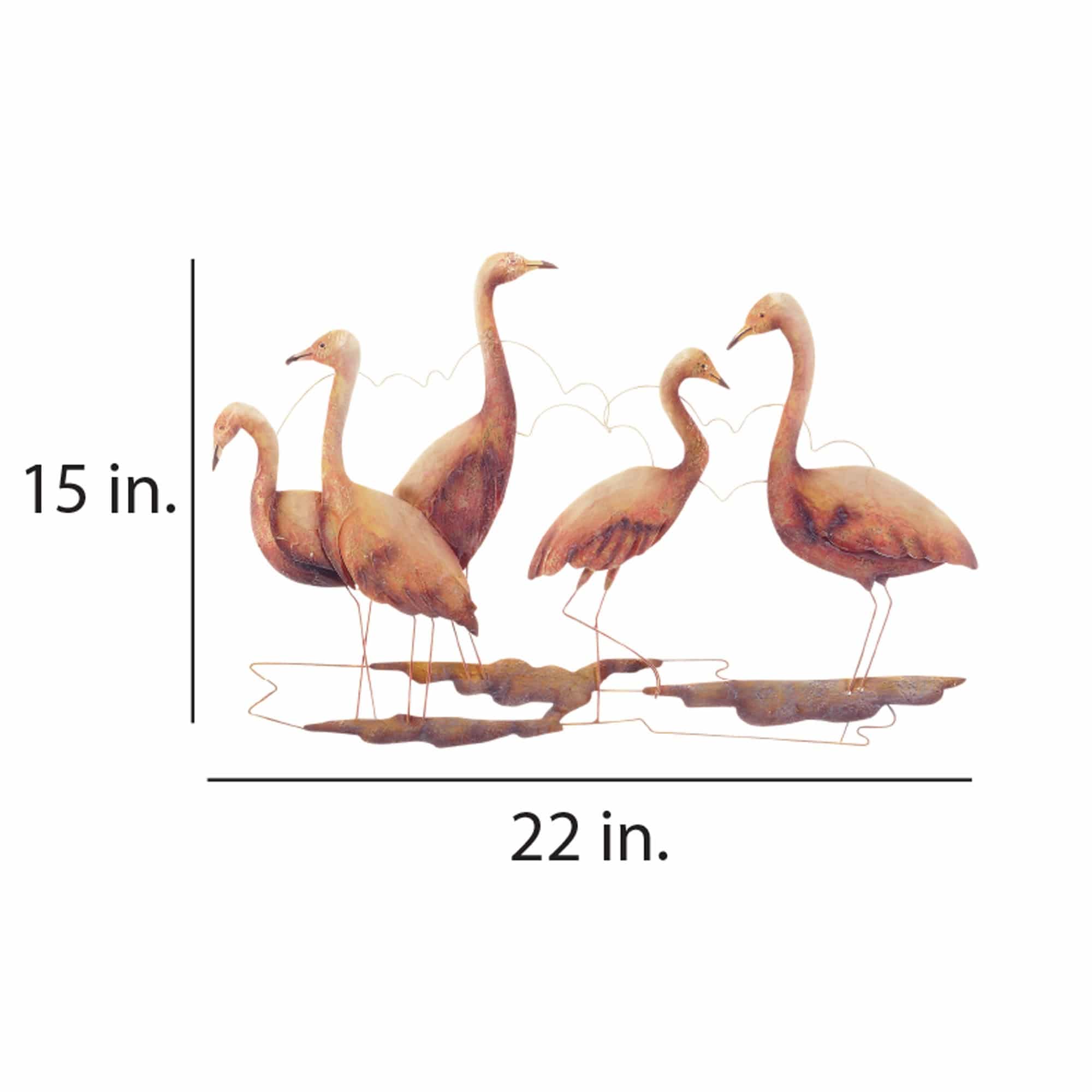
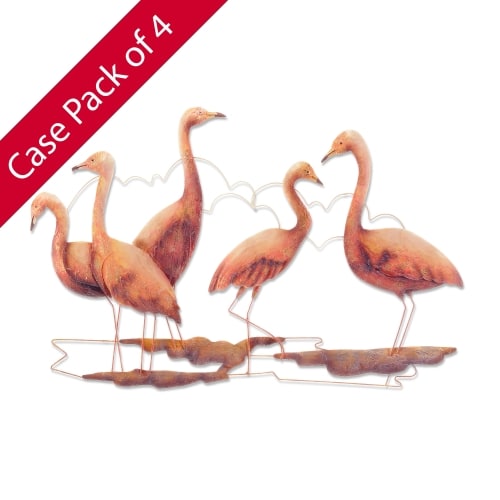 Case of 4 The name 'flamingo' comes from the Portuguese or Spanish 'flamengo,' which means 'flame-colored.' Born gray in hues, flamingos get their flamboyant color from brine shrimp that make up most of their diet. Flamingos are very social animals and the artist depicts this by creating a group of five birds wading through the calm water enjoying a warm day. The artist takes time in pressing the metal creating texture in the wings and body, and also uses metallic paints to highlight the famous colors of one of the most recognizable birds on the planet. The basic frame of this piece is created using tin, which is powder coated with a black finish. The frame is reinforced using tin wire along the inner edge. The front of the body is adorned with capiz. Capiz is an oyster shell and the primary purpose of the oyster is as a source of food. However, the by-product, the shell, can be used for decoration. Due to it being a natural material, the natural colors of the capiz may come through as tans and browns underneath the hand-painted surface.
Case of 4 The name 'flamingo' comes from the Portuguese or Spanish 'flamengo,' which means 'flame-colored.' Born gray in hues, flamingos get their flamboyant color from brine shrimp that make up most of their diet. Flamingos are very social animals and the artist depicts this by creating a group of five birds wading through the calm water enjoying a warm day. The artist takes time in pressing the metal creating texture in the wings and body, and also uses metallic paints to highlight the famous colors of one of the most recognizable birds on the planet. The basic frame of this piece is created using tin, which is powder coated with a black finish. The frame is reinforced using tin wire along the inner edge. The front of the body is adorned with capiz. Capiz is an oyster shell and the primary purpose of the oyster is as a source of food. However, the by-product, the shell, can be used for decoration. Due to it being a natural material, the natural colors of the capiz may come through as tans and browns underneath the hand-painted surface. -
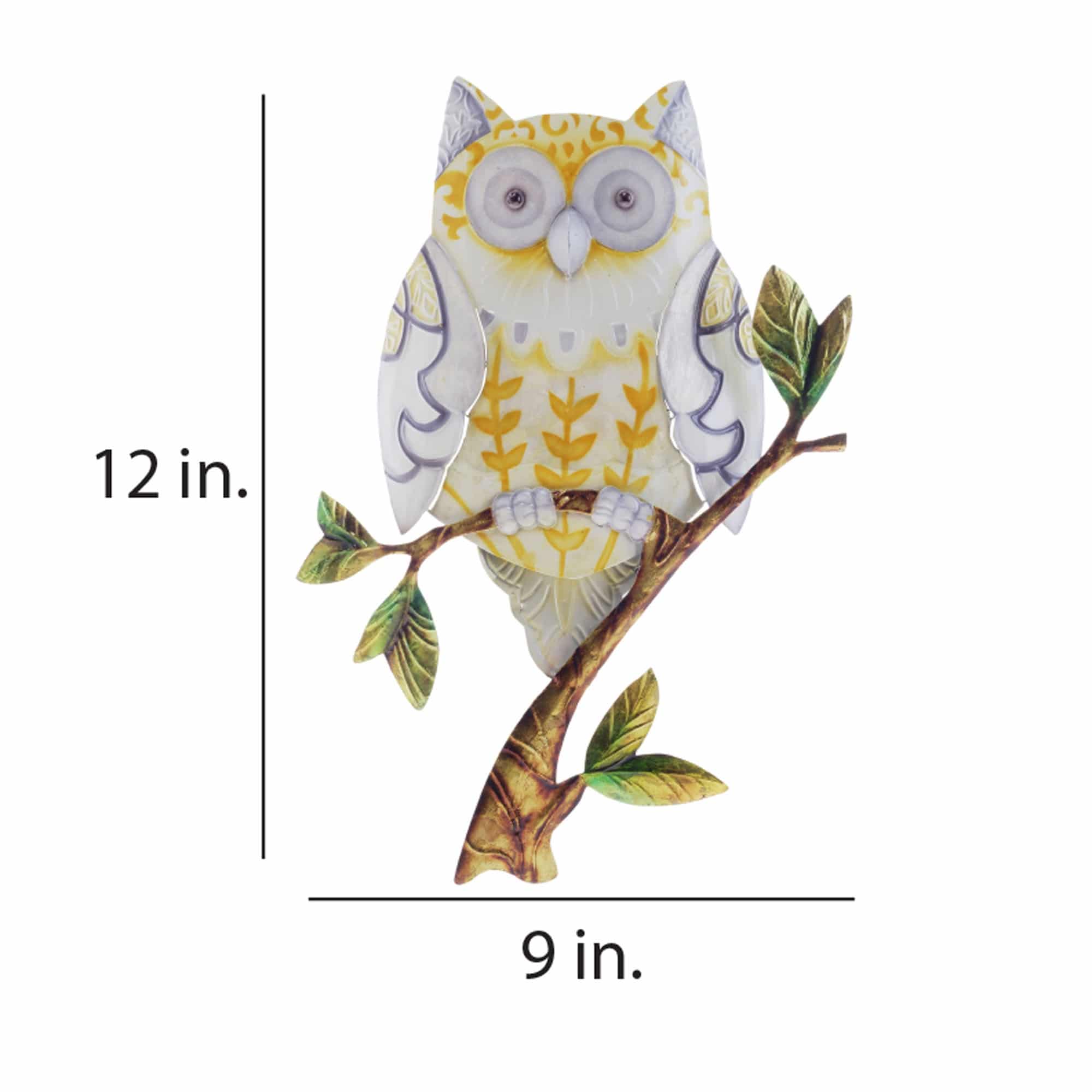
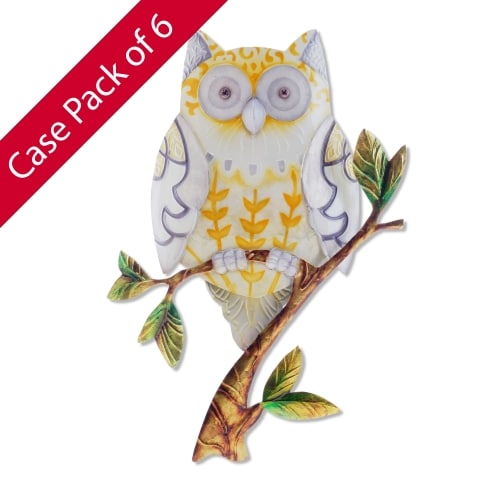 Case of 6 The owl was a bird of prophecy and wisdom in many ancient cultures. Its wide eyes seem to miss nothing and when an owl moves it seems calculated. Even though the colors and designs on the owl are human interpretations, the perched look is defiantly natural. The artist uses capiz shell on the wings to highlight the reflective nature of some of the owl's feathers. The basic frame of the owl is created using tin, which is powder coated with a black finish. The frame is reinforced using tin wire along the inner edge. Capiz is an oyster shell and the primary purpose of the oyster is as a source of food. However, the by-product, the shell, can be used for decoration.
Case of 6 The owl was a bird of prophecy and wisdom in many ancient cultures. Its wide eyes seem to miss nothing and when an owl moves it seems calculated. Even though the colors and designs on the owl are human interpretations, the perched look is defiantly natural. The artist uses capiz shell on the wings to highlight the reflective nature of some of the owl's feathers. The basic frame of the owl is created using tin, which is powder coated with a black finish. The frame is reinforced using tin wire along the inner edge. Capiz is an oyster shell and the primary purpose of the oyster is as a source of food. However, the by-product, the shell, can be used for decoration. -
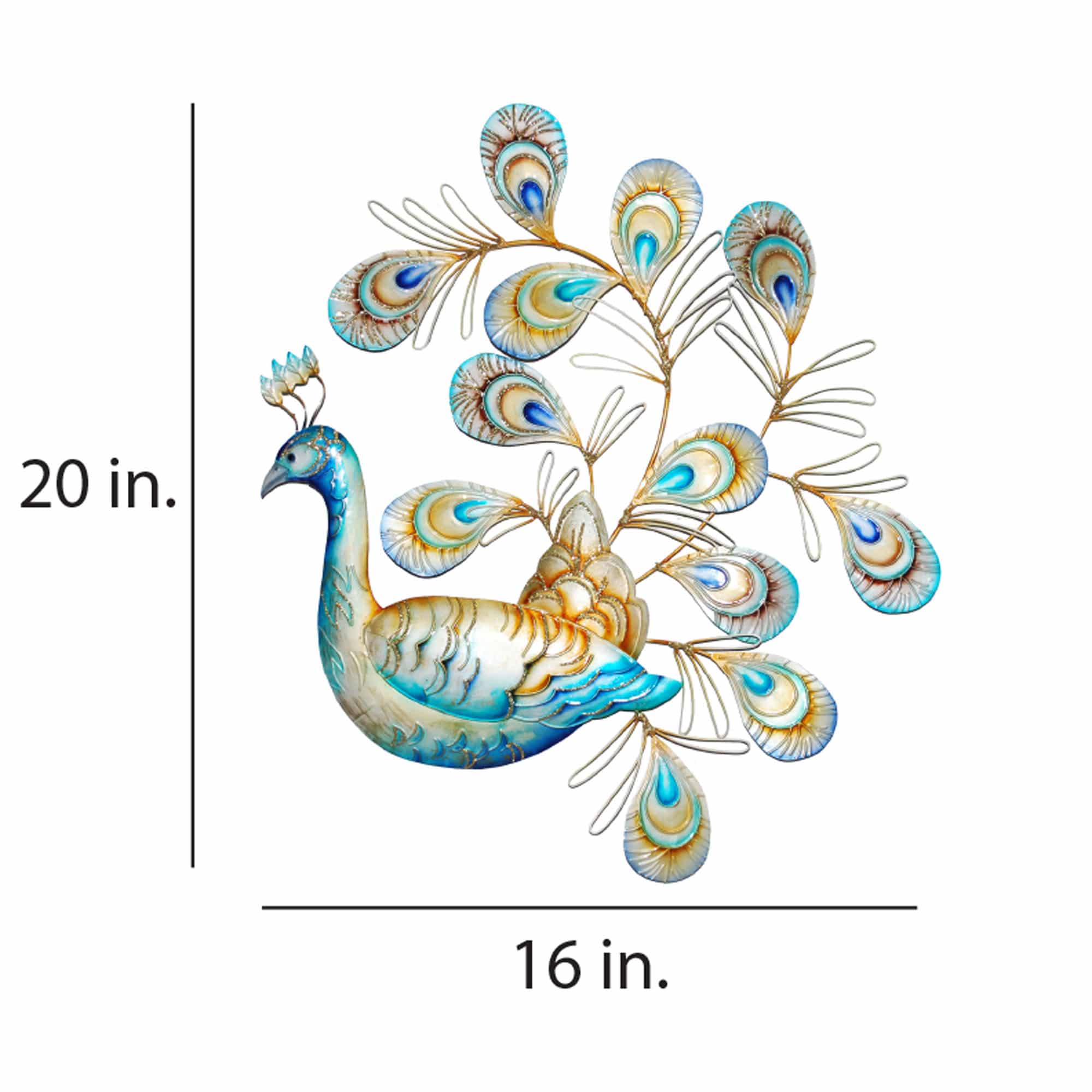
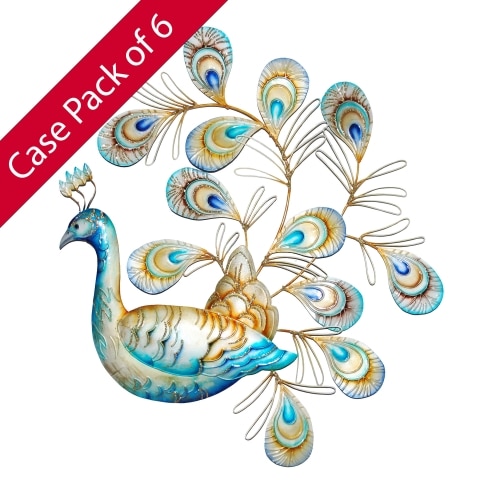 Case of 4 Tailfeathers raised, this Indian peacock is strutting his stuff. On display is its iridescent blue and green, metallic-colored, plumage. Throughout its tailfeathers, the artists drew in the peacock's distinctive eyespots, with the eye itself in different colors. The chest of the bird is crafted from capiz shell, carefully painted in the blues and greens this bird is known for. It fits perfectly within any decor style and will add the finishing touch to its surroundings. The basic frame of this piece is created using tin, which is powder coated with a black finish. The frame is reinforced using tin wire along the inner edge. The front of the body is adorned with capiz. Capiz is an oyster shell and the primary purpose of the oyster is as a source of food. However, the by-product, the shell, can be used for decoration. Due to it being a natural material, the natural colors of the capiz may come through as tans and browns underneath the hand-painted surface.
Case of 4 Tailfeathers raised, this Indian peacock is strutting his stuff. On display is its iridescent blue and green, metallic-colored, plumage. Throughout its tailfeathers, the artists drew in the peacock's distinctive eyespots, with the eye itself in different colors. The chest of the bird is crafted from capiz shell, carefully painted in the blues and greens this bird is known for. It fits perfectly within any decor style and will add the finishing touch to its surroundings. The basic frame of this piece is created using tin, which is powder coated with a black finish. The frame is reinforced using tin wire along the inner edge. The front of the body is adorned with capiz. Capiz is an oyster shell and the primary purpose of the oyster is as a source of food. However, the by-product, the shell, can be used for decoration. Due to it being a natural material, the natural colors of the capiz may come through as tans and browns underneath the hand-painted surface. -

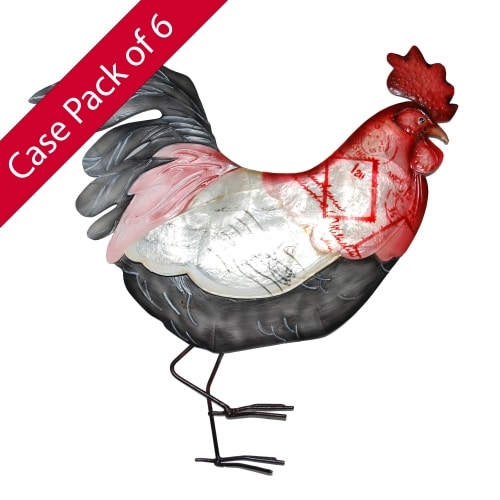 Case of 6 This vintage designed rooster is influenced by the designs of the early 20th century. The artist took great care in making sure the rooster's comb and wattle appear authentic by pressing texture into the metal frame. Furthermore, the artist made sure to use realistic colors and shading. Even the body and the tail feathers were pressed and cut to mimic the body of a real rooster. However, the center of the rooster deviates from the realism and merges into the nostalgic with what appears to be an envelope of an old handwritten letter. The capiz oyster shell gives an aged patina making the rooster and the letter feel like it has been around for a very long time. The letter is an artistic way of tying in a piece of the old into the new. The basic frame of this piece is created using tin, which is powder coated with a black finish. The frame is reinforced using tin wire along the inner edge. The front of the body is adorned with capiz. Capiz is an oyster shell and the primary purpose of the oyster is as a source of food. However, the by-product, the shell, can be used for decoration. Due to it being a natural material, the natural colors of the capiz may come through as tans and browns underneath the hand-painted surface.
Case of 6 This vintage designed rooster is influenced by the designs of the early 20th century. The artist took great care in making sure the rooster's comb and wattle appear authentic by pressing texture into the metal frame. Furthermore, the artist made sure to use realistic colors and shading. Even the body and the tail feathers were pressed and cut to mimic the body of a real rooster. However, the center of the rooster deviates from the realism and merges into the nostalgic with what appears to be an envelope of an old handwritten letter. The capiz oyster shell gives an aged patina making the rooster and the letter feel like it has been around for a very long time. The letter is an artistic way of tying in a piece of the old into the new. The basic frame of this piece is created using tin, which is powder coated with a black finish. The frame is reinforced using tin wire along the inner edge. The front of the body is adorned with capiz. Capiz is an oyster shell and the primary purpose of the oyster is as a source of food. However, the by-product, the shell, can be used for decoration. Due to it being a natural material, the natural colors of the capiz may come through as tans and browns underneath the hand-painted surface. -
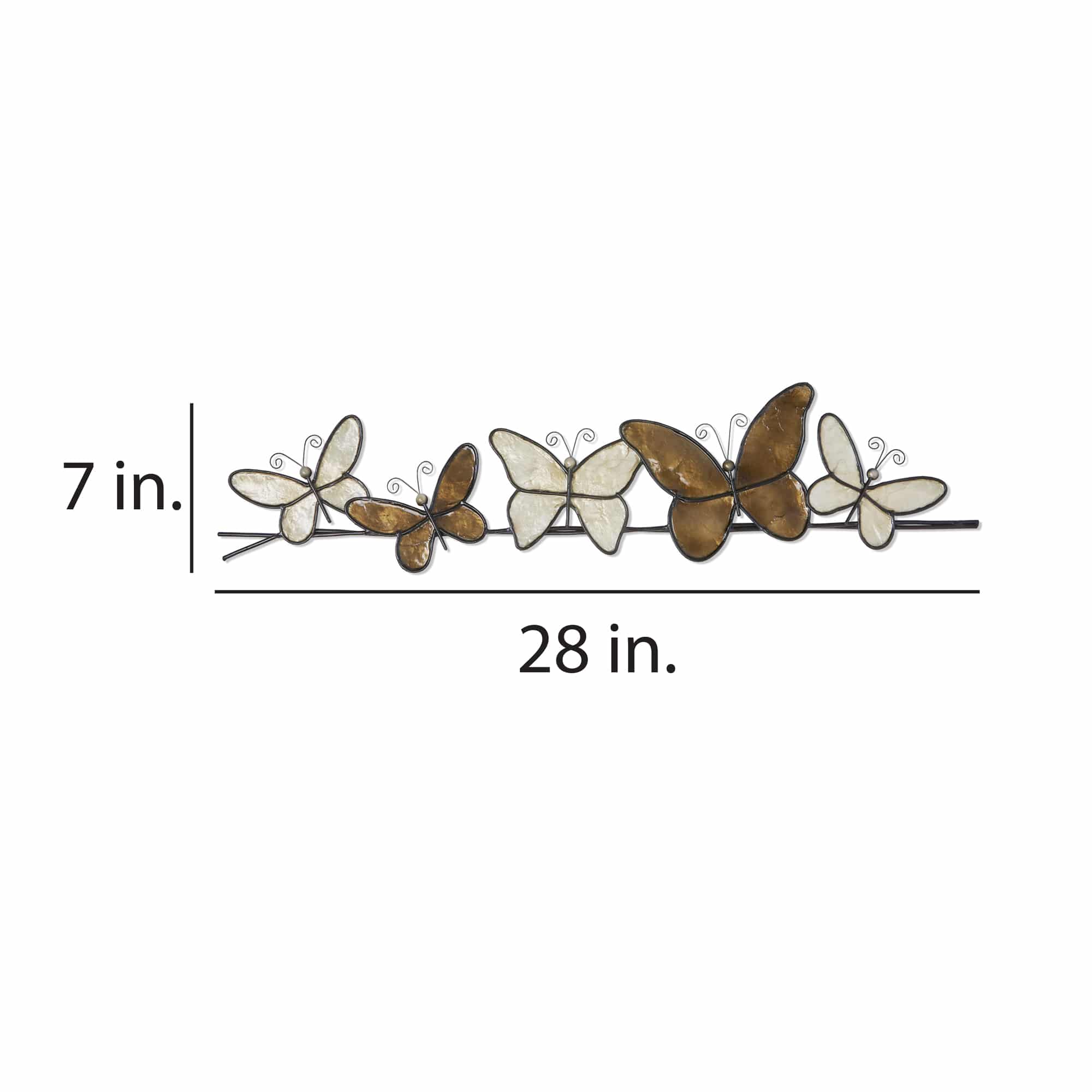
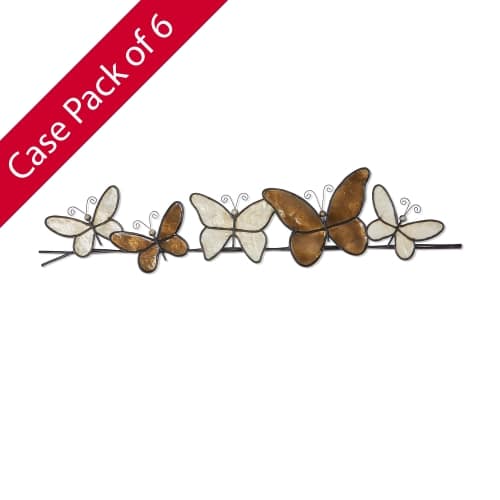 Case of 6
Case of 6Five, fluttering butterflies are ready to complete their journey after taking a break from a long migration. The slender, metal body of each butterfly connects to colorful capiz-shell wings which catches light and adds shine. Each wing is framed using sturdy wrought iron and reinforced with a metal backing.
The basic frame of the butterfly is created using tin, which is powder-coated with a black finish and makes this piece safe to use outdoors. The edges of the frame are reinforced using thicker tin wire. The front of this piece is adorned in areas with capiz shell, an oyster native to the Philippines, before being hand-painted and sealed with a water-based sealant. The primary purpose of this oyster to provide a source of food, however, the shell is a sustainable by-product that can be used for decoration. The capiz shell subtly replicates the reflective qualities of butterflies in nature. The entire piece is lightweight and has an eyelet in the back allowing it to be hung using a finishing nail, command strip, or a push pin. Due to it being a natural material, the organic colors of capiz come through as tans and browns underneath the paint.
-

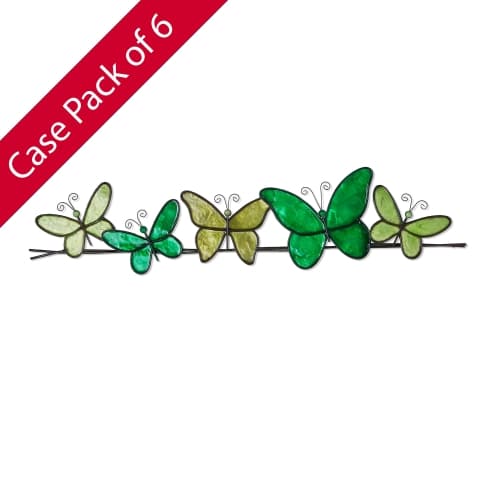 Case of 6 Five, fluttering butterflies are ready to complete their journey after taking a break from a long migration. The slender, metal body of each butterfly connects to colorful capiz-shell wings which catches light and adds shine. Each wing is framed using sturdy wrought iron and reinforced with a metal backing. The basic frame of the butterfly is created using tin, which is powder-coated with a black finish and makes this piece safe to use outdoors. The edges of the frame are reinforced using thicker tin wire. The front of this piece is adorned in areas with capiz shell, an oyster native to the Philippines, before being hand-painted and sealed with a water-based sealant. The primary purpose of this oyster to provide a source of food, however, the shell is a sustainable by-product that can be used for decoration. The capiz shell subtly replicates the reflective qualities of butterflies in nature. The entire piece is lightweight and has an eyelet in the back allowing it to be hung using a finishing nail, command strip, or a push pin. Due to it being a natural material, the organic colors of capiz come through as tans and browns underneath the paint.
Case of 6 Five, fluttering butterflies are ready to complete their journey after taking a break from a long migration. The slender, metal body of each butterfly connects to colorful capiz-shell wings which catches light and adds shine. Each wing is framed using sturdy wrought iron and reinforced with a metal backing. The basic frame of the butterfly is created using tin, which is powder-coated with a black finish and makes this piece safe to use outdoors. The edges of the frame are reinforced using thicker tin wire. The front of this piece is adorned in areas with capiz shell, an oyster native to the Philippines, before being hand-painted and sealed with a water-based sealant. The primary purpose of this oyster to provide a source of food, however, the shell is a sustainable by-product that can be used for decoration. The capiz shell subtly replicates the reflective qualities of butterflies in nature. The entire piece is lightweight and has an eyelet in the back allowing it to be hung using a finishing nail, command strip, or a push pin. Due to it being a natural material, the organic colors of capiz come through as tans and browns underneath the paint. -
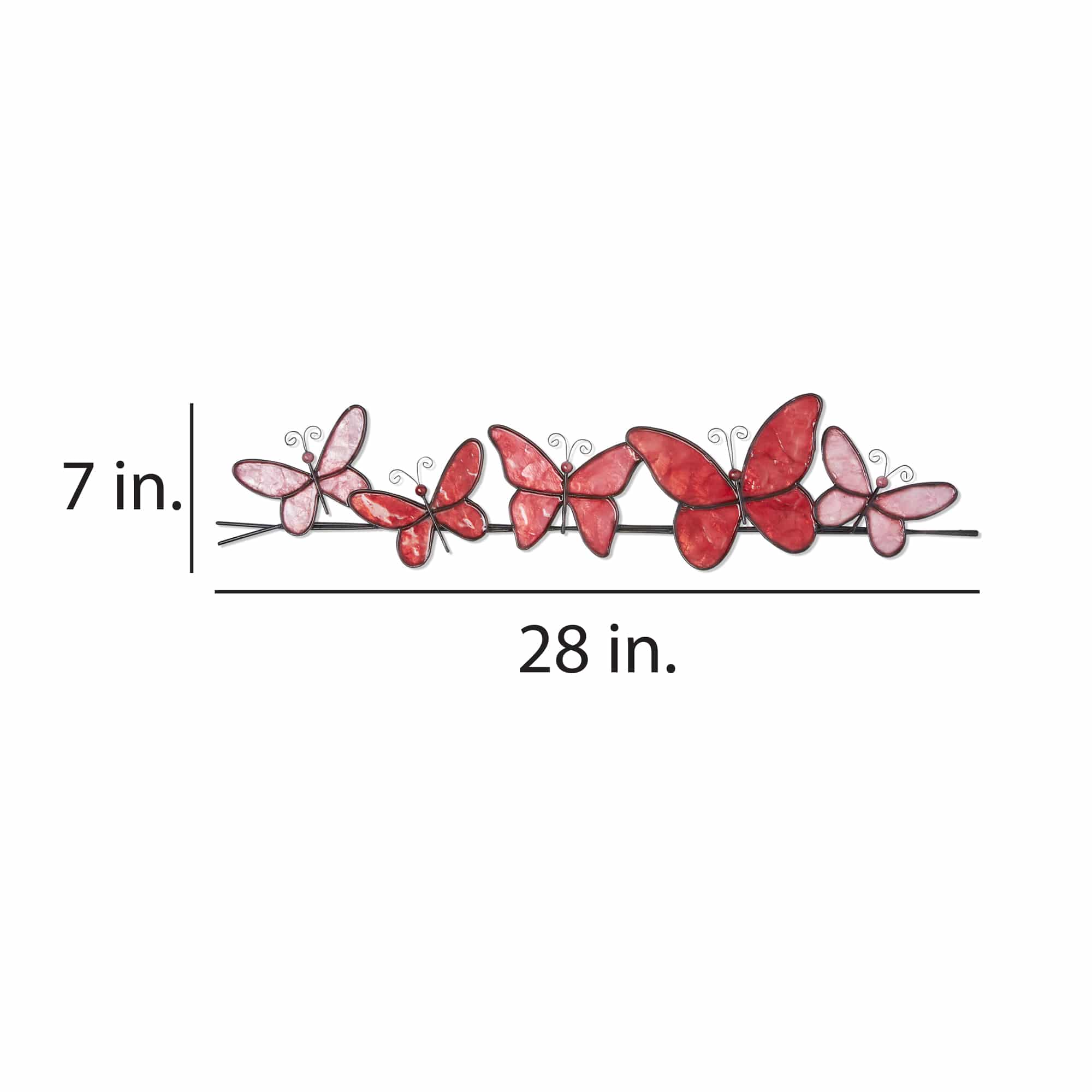
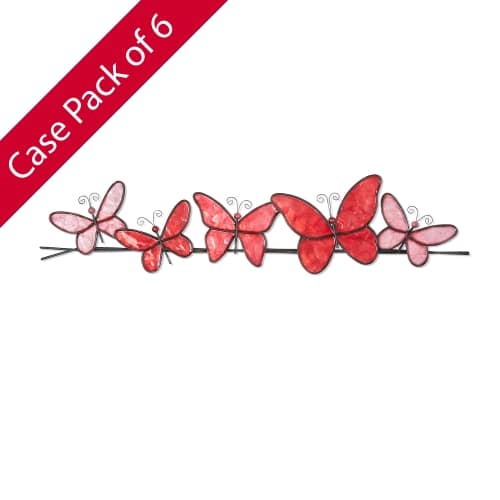 Case of 6
Case of 6Five, fluttering butterflies are ready to complete their journey after taking a break from a long migration. The slender, metal body of each butterfly connects to colorful capiz-shell wings which catches light and adds shine. Each wing is framed using sturdy wrought iron and reinforced with a metal backing.
The basic frame of the butterfly is created using tin, which is powder-coated with a black finish and makes this piece safe to use outdoors. The edges of the frame are reinforced using thicker tin wire. The front of this piece is adorned in areas with capiz shell, an oyster native to the Philippines, before being hand-painted and sealed with a water-based sealant. The primary purpose of this oyster to provide a source of food, however, the shell is a sustainable by-product that can be used for decoration. The capiz shell subtly replicates the reflective qualities of butterflies in nature. The entire piece is lightweight and has an eyelet in the back allowing it to be hung using a finishing nail, command strip, or a push pin. Due to it being a natural material, the organic colors of capiz come through as tans and browns underneath the paint.
-
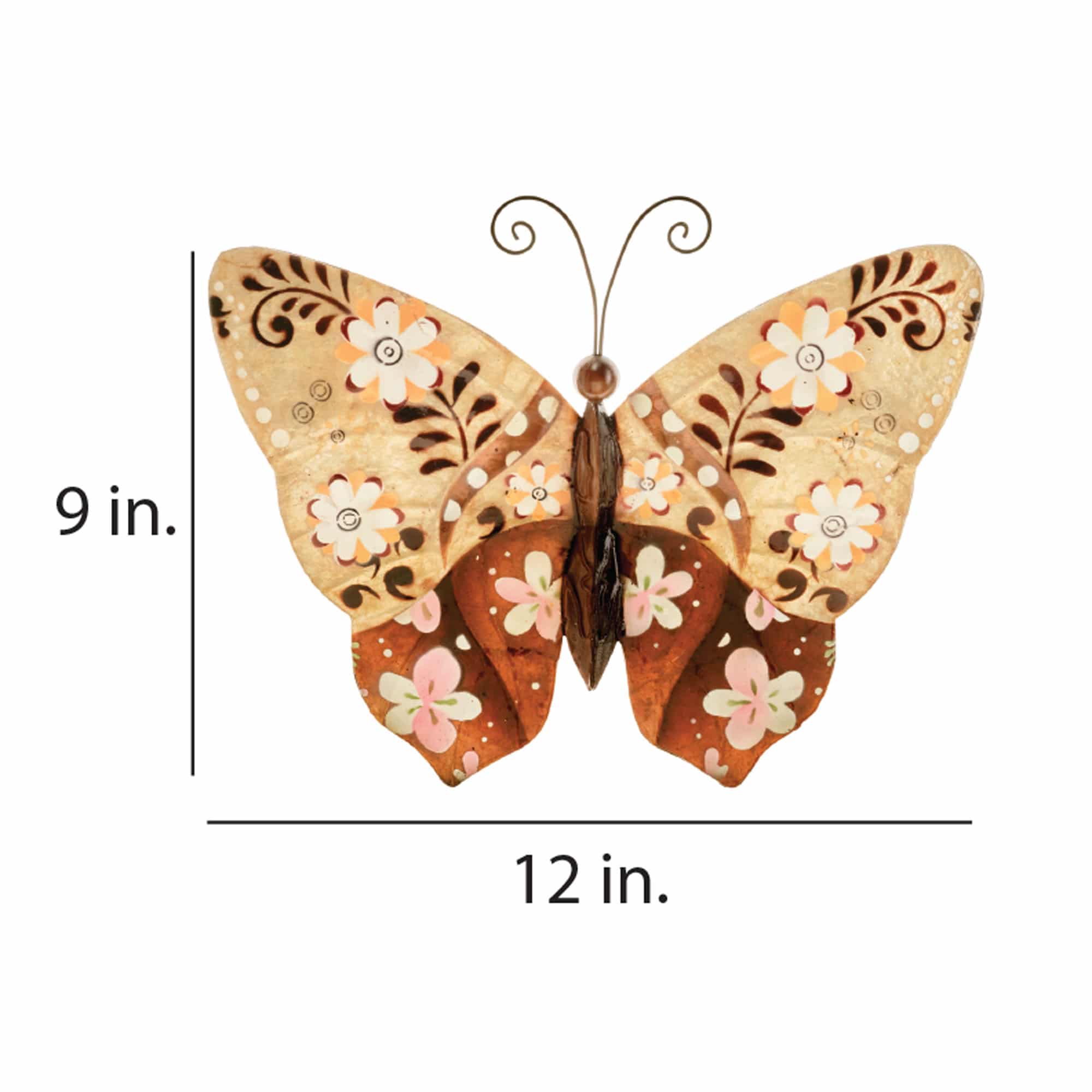
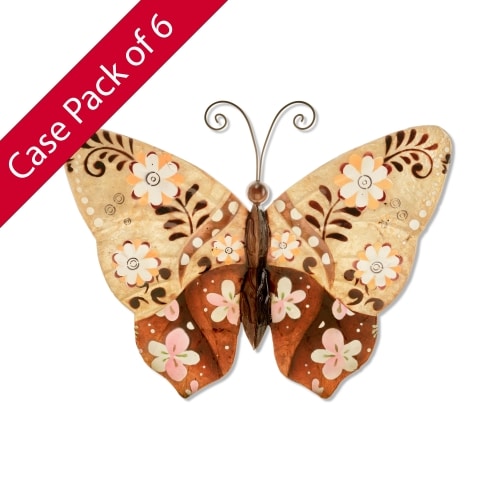 Case of 6
Case of 6With its warm earth and cream tones, this butterfly features whimsical flowers with sophisticated patterns. Calming and soothing, the understated elegance enhances its surroundings with the beauty of pattern and texture.
The basic frame of the butterfly is created using tin, which is powder-coated with a black finish and makes this piece safe to use outdoors. The edges of the frame are reinforced using thicker tin wire. The front of this piece is adorned in areas with capiz shell, an oyster native to the Philippines, before being hand-painted and sealed with a water-based sealant. The primary purpose of this oyster to provide a source of food, however, the shell is a sustainable by-product that can be used for decoration. The capiz shell subtly replicates the reflective qualities of butterflies in nature. The entire piece is lightweight and has an eyelet in the back allowing it to be hung using a finishing nail, command strip, or a push pin. Due to it being a natural material, the organic colors of capiz come through as tans and browns underneath the paint.
-
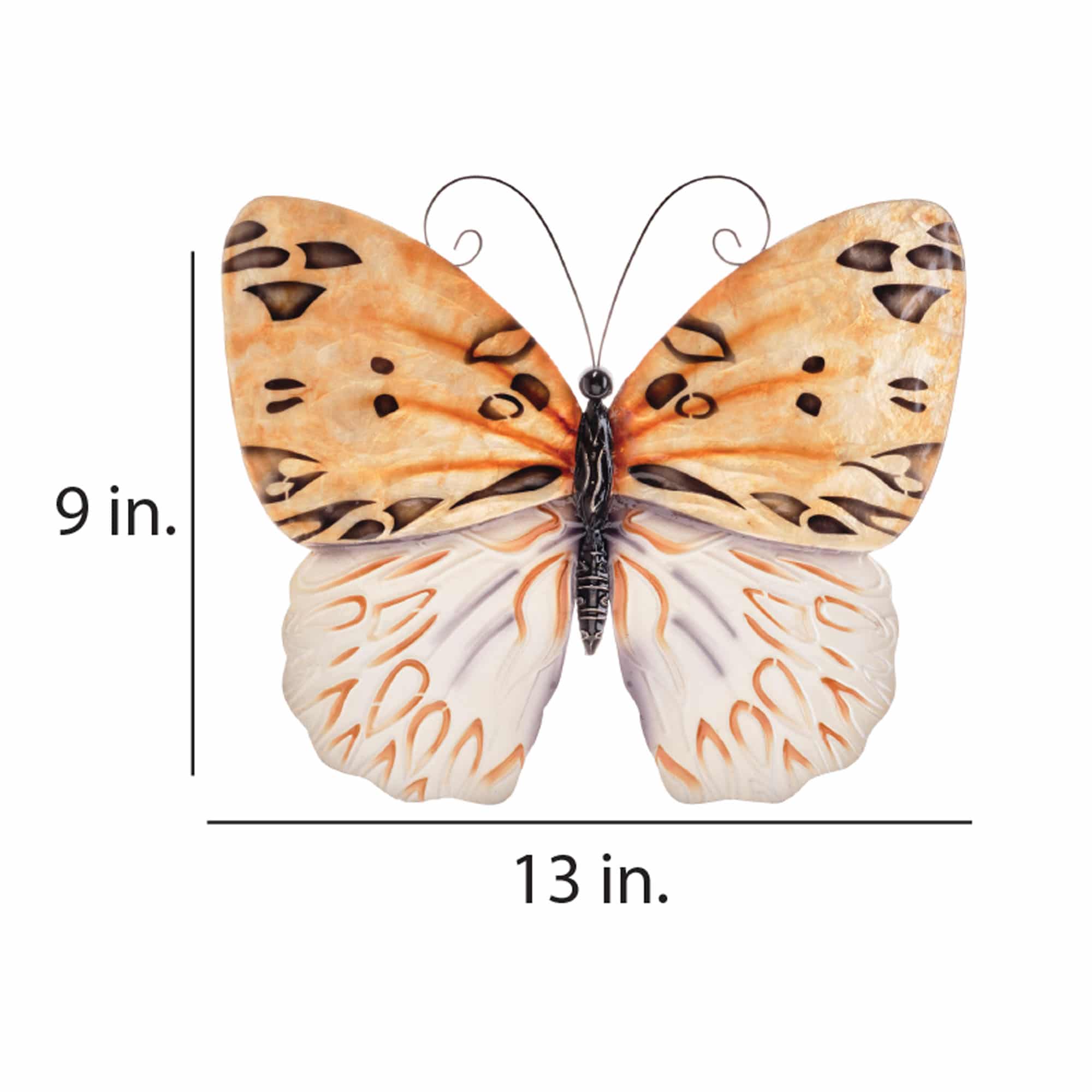
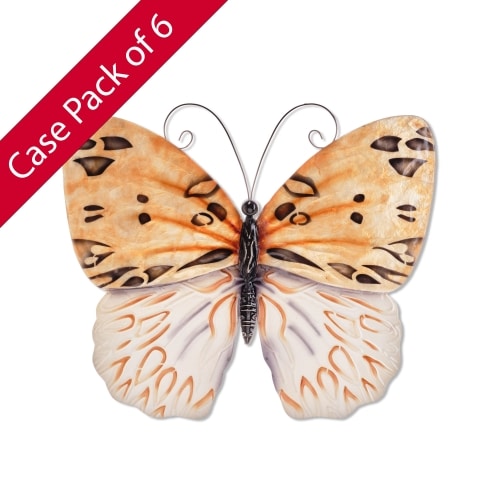 Case of 6
Case of 6Using paints of various shades and different hues of yellow, this graceful butterfly features an appearance of flowing honey on its upper wings. The lower wings diverge from the honey and are textured in a base white color with highlights of yellow. Stylish and elegant, this piece adds sophistication to the finish of any room, contemporary or traditional.
The basic frame of the butterfly is created using tin, which is powder-coated with a black finish and makes this piece safe to use outdoors. The edges of the frame are reinforced using thicker tin wire. The front of this piece is adorned in areas with capiz shell, an oyster native to the Philippines, before being hand-painted and sealed with a water-based sealant. The primary purpose of this oyster to provide a source of food, however, the shell is a sustainable by-product that can be used for decoration. The capiz shell subtly replicates the reflective qualities of butterflies in nature. The entire piece is lightweight and has an eyelet in the back allowing it to be hung using a finishing nail, command strip, or a push pin. Due to it being a natural material, the organic colors of capiz come through as tans and browns underneath the paint.
-
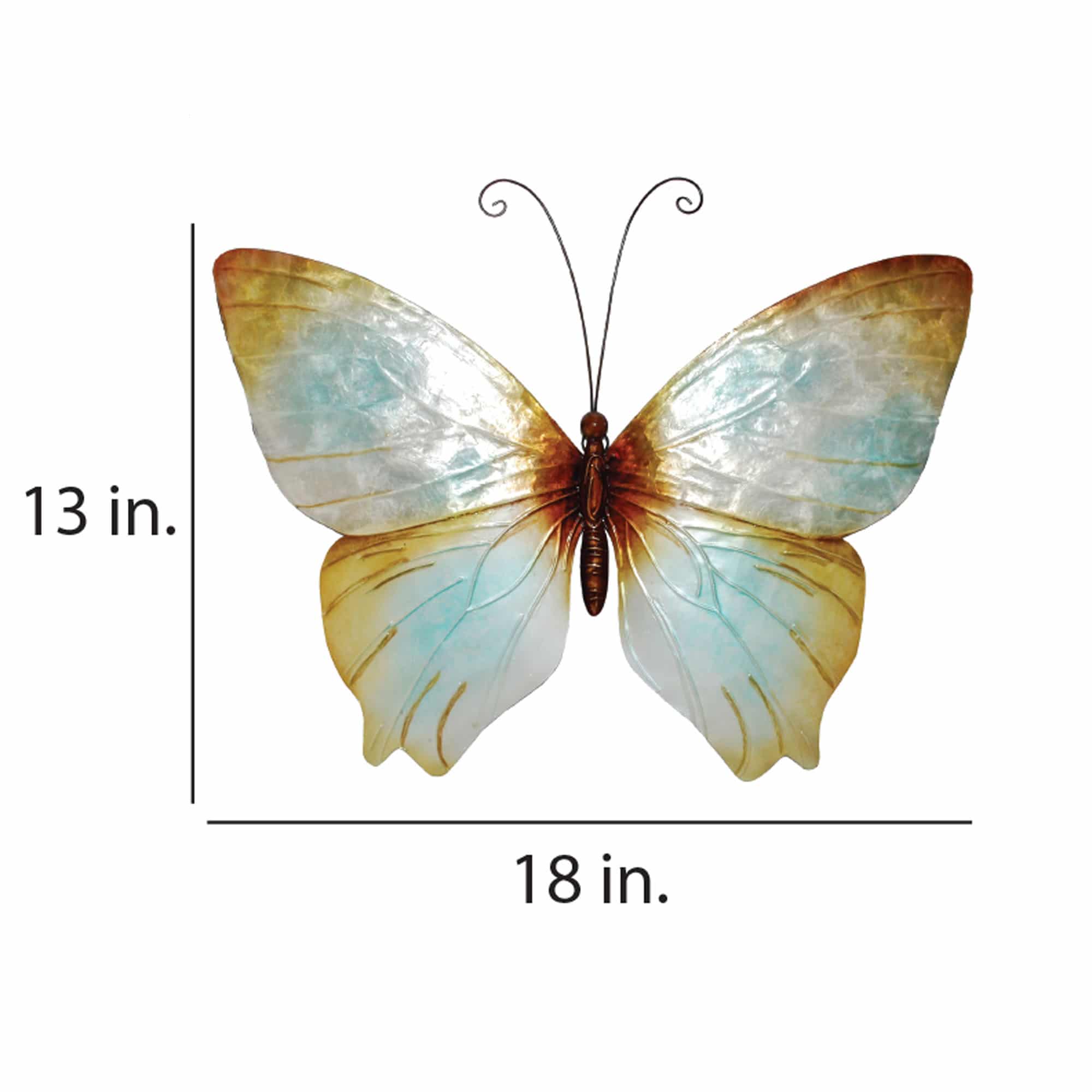
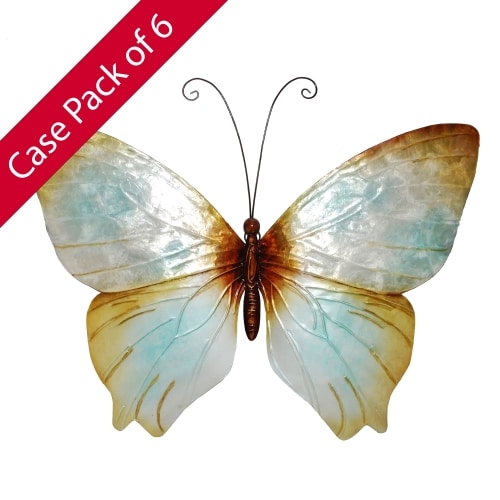 Case of 6
Case of 6The colors of the wings are inspired by the water of a crystal-clear lake, making the pearl wings feel translucent next to the dark body. The long flowing antenna and the shape of this butterfly provide a classic feel to this very familiar form.
The basic frame of the butterfly is created using tin, which is powder-coated with a black finish and makes this piece safe to use outdoors. The edges of the frame are reinforced using thicker tin wire. The front of this piece is adorned in areas with capiz shell, an oyster native to the Philippines, before being hand-painted and sealed with a water-based sealant. The primary purpose of this oyster to provide a source of food, however, the shell is a sustainable by-product that can be used for decoration. The capiz shell subtly replicates the reflective qualities of butterflies in nature. The entire piece is lightweight and has an eyelet in the back allowing it to be hung using a finishing nail, command strip, or a push pin. Due to it being a natural material, the organic colors of capiz come through as tans and browns underneath the paint.
-
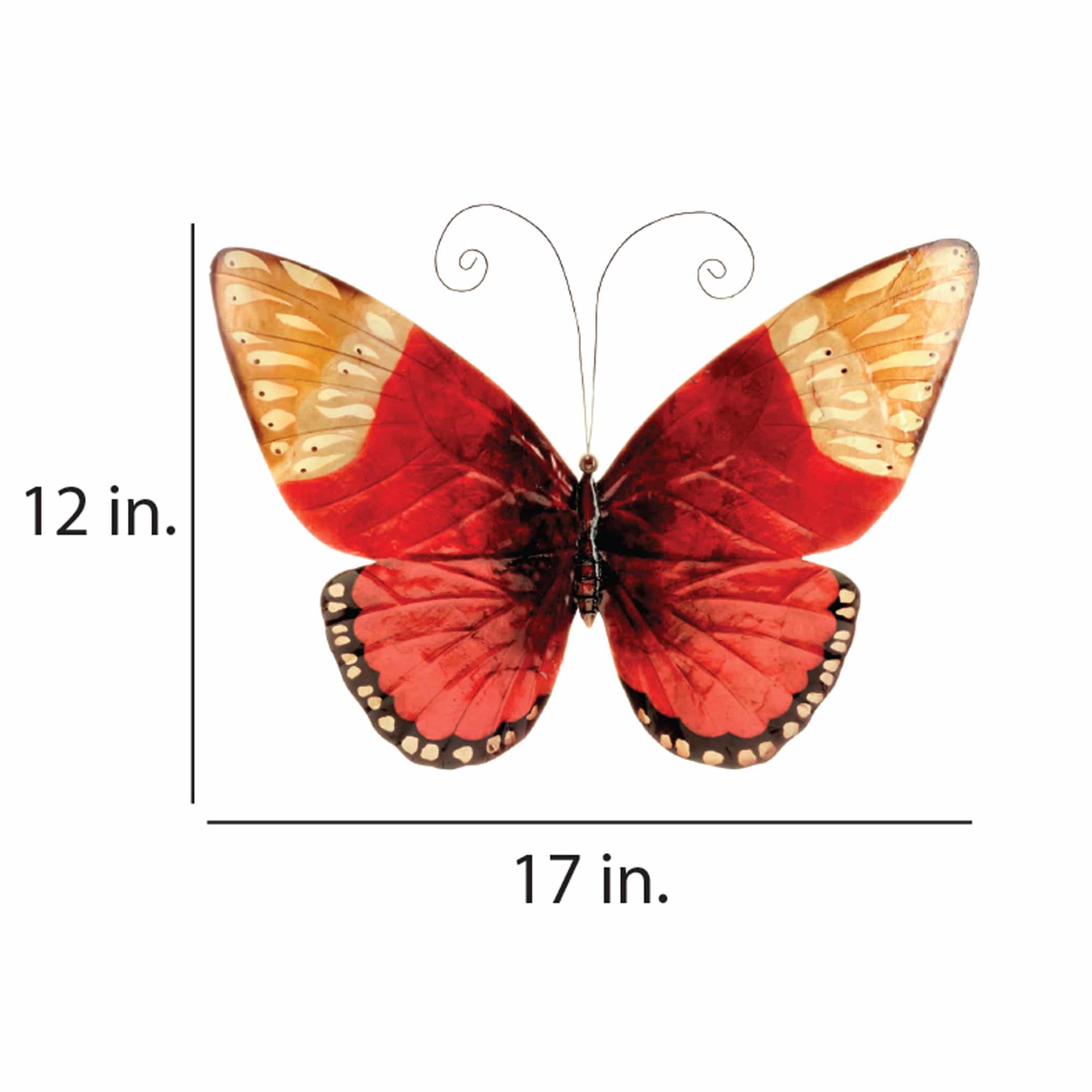
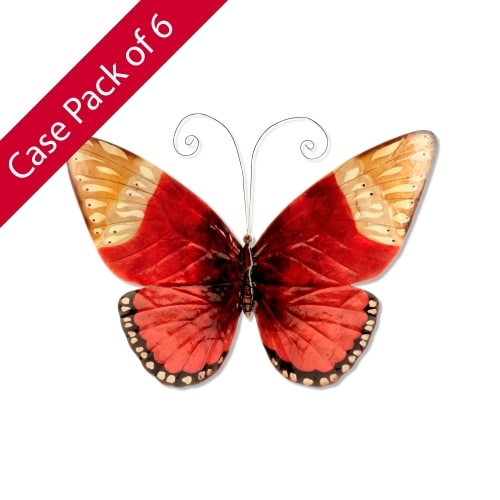 Case of 6
Case of 6This butterfly is large and bold with its striking bright red body. But this butterfly isn't mono-colored. Instead the artist uses different shading techniques and mother of pearl oyster shell to bring in depth as well as strong color. The artist further enhances the butterfly by adding brown feathering to the wing-tips.
The basic frame of the butterfly is created using tin, which is powder-coated with a black finish and makes this piece safe to use outdoors. The edges of the frame are reinforced using thicker tin wire. The front of this piece is adorned in areas with capiz shell, an oyster native to the Philippines, before being hand-painted and sealed with a water-based sealant. The primary purpose of this oyster to provide a source of food, however, the shell is a sustainable by-product that can be used for decoration. The capiz shell subtly replicates the reflective qualities of butterflies in nature. The entire piece is lightweight and has an eyelet in the back allowing it to be hung using a finishing nail, command strip, or a push pin. Due to it being a natural material, the organic colors of capiz come through as tans and browns underneath the paint.
-
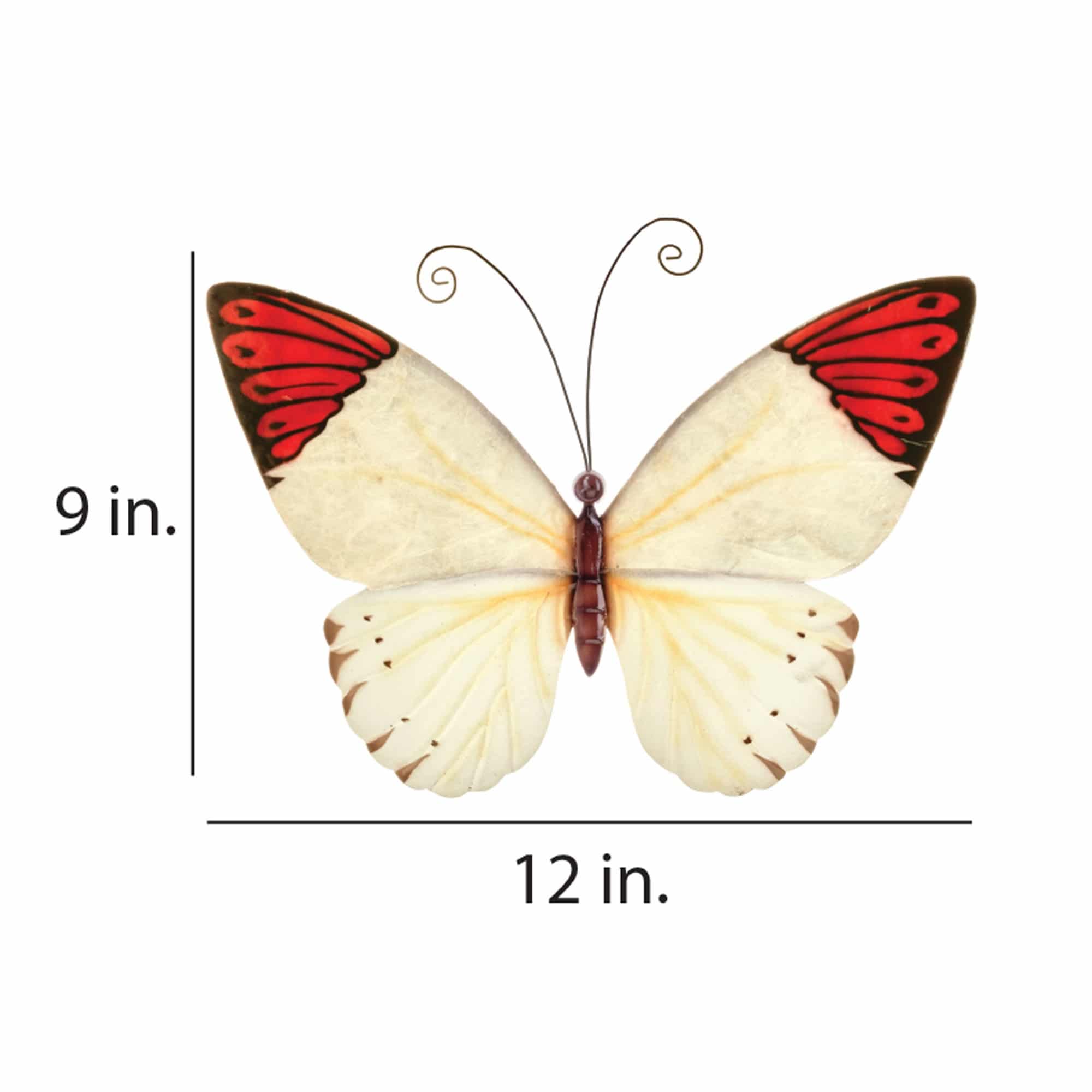
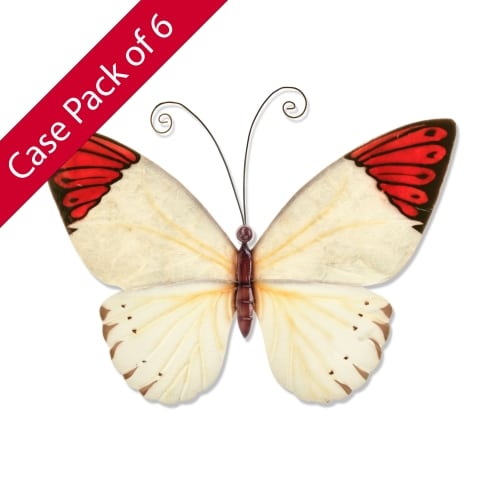 Case of 6 Starting with a base color of pearl white, the artist uses different techniques and splashes of color to craft a distinctive piece. The upper wings are created using capiz oyster shell, left natural to bring in different natural hues. The red base color is accented using brown feathering patterns. The lower portion of the wing is made of tin, textured to highlight the lines that stem from the body of the butterfly. The basic frame of the butterfly is created using tin, which is powder-coated with a black finish and makes this piece safe to use outdoors. The edges of the frame are reinforced using thicker tin wire. The front of this piece is adorned in areas with capiz shell, an oyster native to the Philippines, before being hand-painted and sealed with a water-based sealant. The primary purpose of this oyster to provide a source of food, however, the shell is a sustainable by-product that can be used for decoration. The capiz shell subtly replicates the reflective qualities of butterflies in nature. The entire piece is lightweight and has an eyelet in the back allowing it to be hung using a finishing nail, command strip, or a push pin. Due to it being a natural material, the organic colors of capiz come through as tans and browns underneath the paint.
Case of 6 Starting with a base color of pearl white, the artist uses different techniques and splashes of color to craft a distinctive piece. The upper wings are created using capiz oyster shell, left natural to bring in different natural hues. The red base color is accented using brown feathering patterns. The lower portion of the wing is made of tin, textured to highlight the lines that stem from the body of the butterfly. The basic frame of the butterfly is created using tin, which is powder-coated with a black finish and makes this piece safe to use outdoors. The edges of the frame are reinforced using thicker tin wire. The front of this piece is adorned in areas with capiz shell, an oyster native to the Philippines, before being hand-painted and sealed with a water-based sealant. The primary purpose of this oyster to provide a source of food, however, the shell is a sustainable by-product that can be used for decoration. The capiz shell subtly replicates the reflective qualities of butterflies in nature. The entire piece is lightweight and has an eyelet in the back allowing it to be hung using a finishing nail, command strip, or a push pin. Due to it being a natural material, the organic colors of capiz come through as tans and browns underneath the paint. -
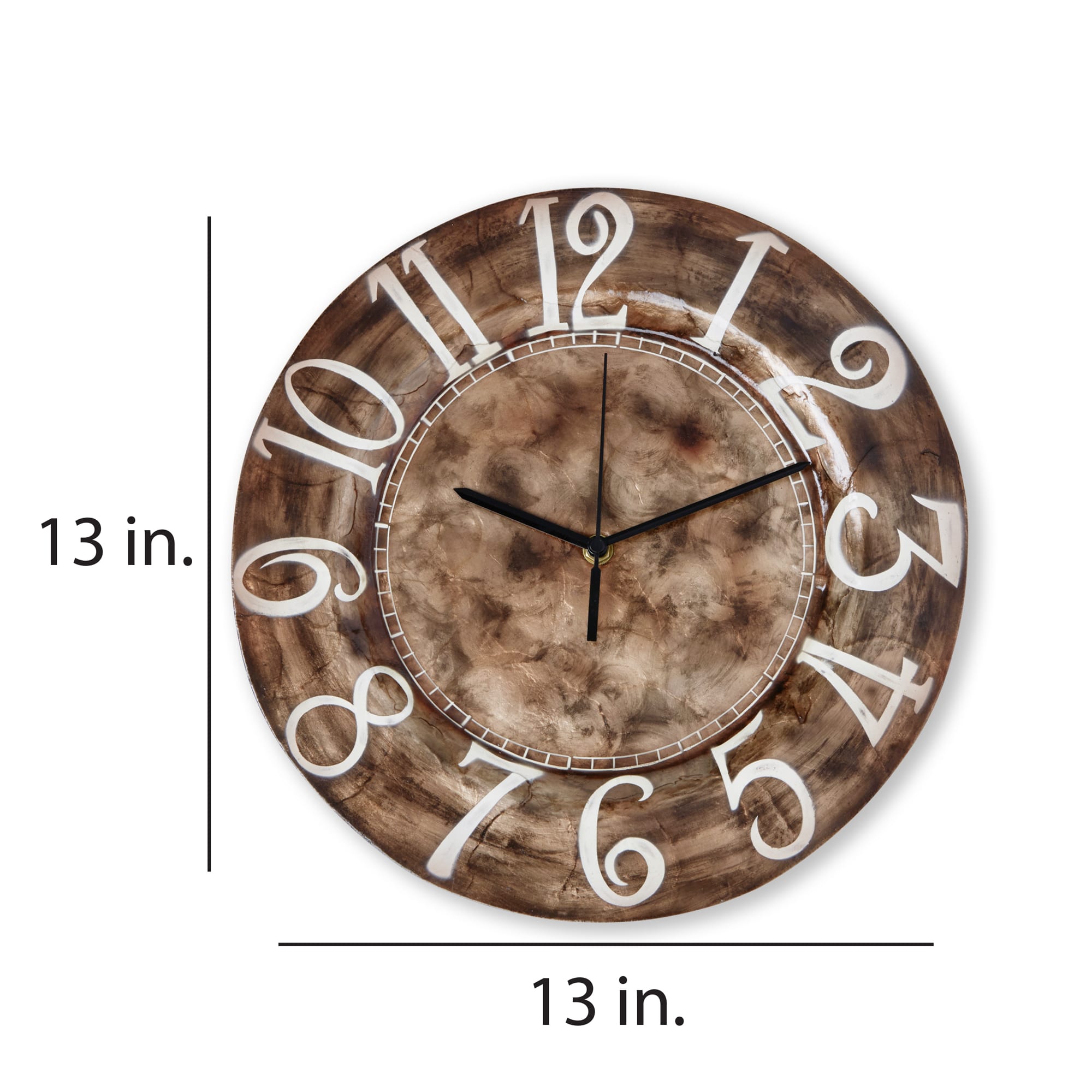
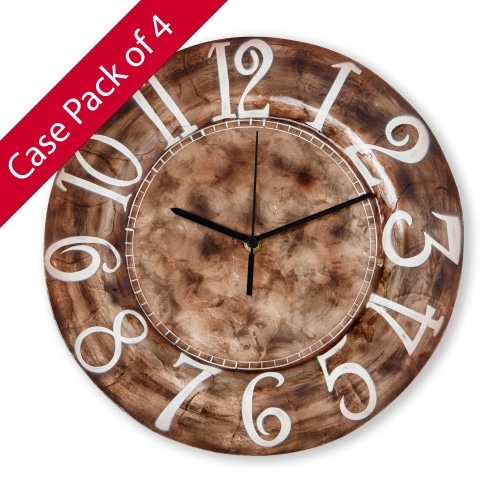 Case of 4 The frame of this clock is made with solid capiz oyster shell, compressed into shape. The texture and lines of the individual shell pieces still come through the broad brush strokes of brown on the background of the clock. The distressed look of the earthy, rich background color giving an aged feel which is complemented by the added detail of the weathered, hand-painted numbers. Capiz is an oyster shell and the primary purpose of the oyster is as a source of food. However, the by-product, the shell, can be used for decoration. The clock is created by compressing capiz shell together and forming it into shape. The final result is a light-weight, plate that feels similar to plastic. Due to it being a natural material, the natural colors of the capiz may come through as tans and browns underneath the hand-painted surface.
Case of 4 The frame of this clock is made with solid capiz oyster shell, compressed into shape. The texture and lines of the individual shell pieces still come through the broad brush strokes of brown on the background of the clock. The distressed look of the earthy, rich background color giving an aged feel which is complemented by the added detail of the weathered, hand-painted numbers. Capiz is an oyster shell and the primary purpose of the oyster is as a source of food. However, the by-product, the shell, can be used for decoration. The clock is created by compressing capiz shell together and forming it into shape. The final result is a light-weight, plate that feels similar to plastic. Due to it being a natural material, the natural colors of the capiz may come through as tans and browns underneath the hand-painted surface. -
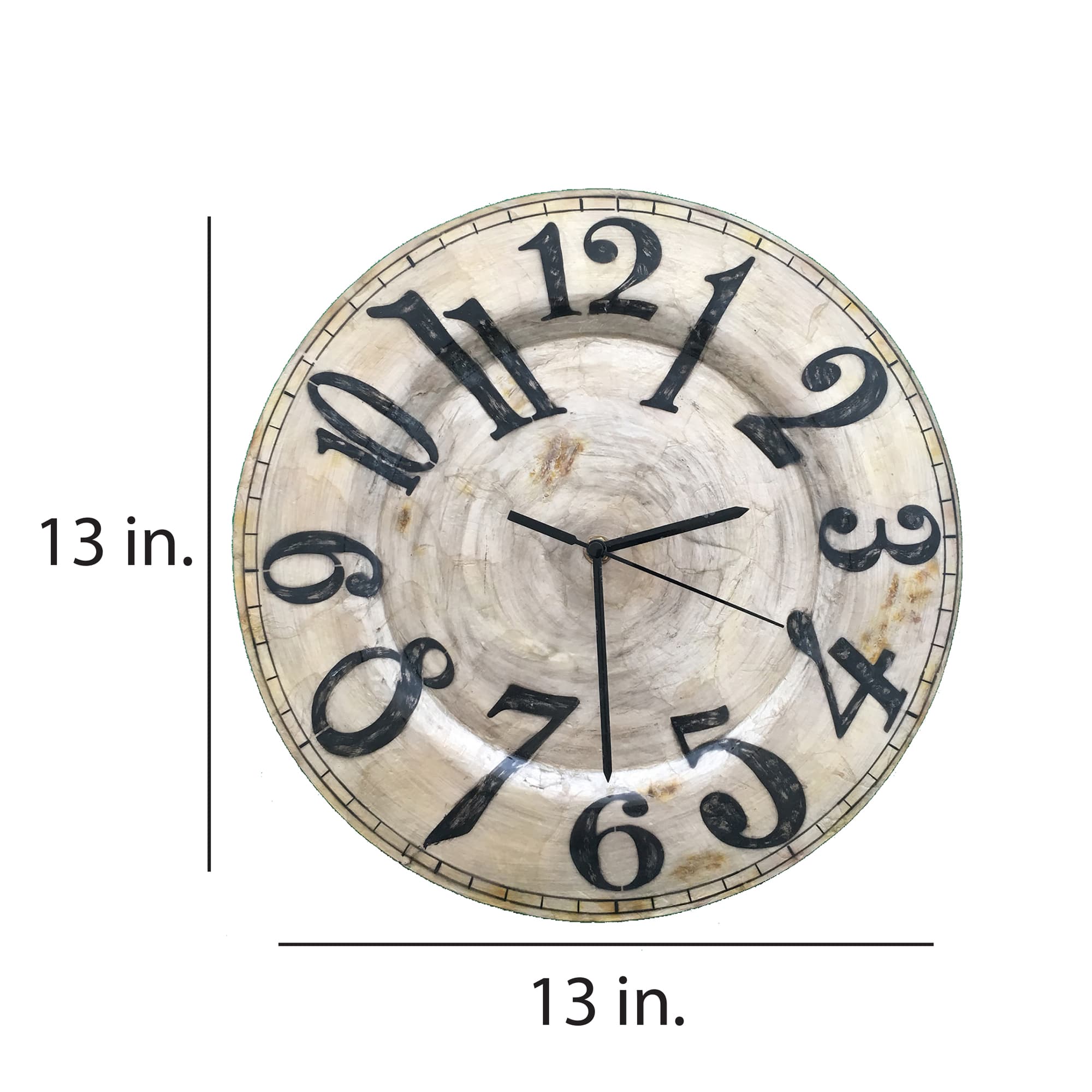
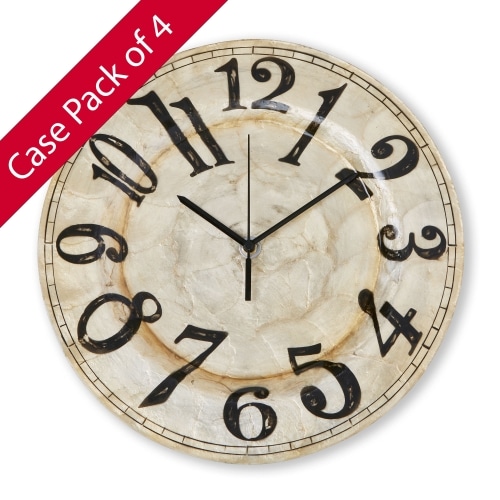 Case of 4 The frame of this clock is made with solid capiz oyster shell, compressed into shape. The face is hand-painted to appear as if it is aged porcelain, promoted by the natual colors of the capiz shell. The look is further accentuated by gentle distressed marks. The black, bold numbers vary in size and stand in strong contrast to the pearl background. The combination of simple color palette and the seasoned feel of the porcelain finish are quintessential hallmarks of the modern farmhouse design genre. Capiz is an oyster shell and the primary purpose of the oyster is as a source of food. However, the by-product, the shell, can be used for decoration. The clock is created by compressing capiz shell together and forming it into shape. The final result is a light-weight, plate that feels similar to plastic. Due to it being a natural material, the natural colors of the capiz may come through as tans and browns underneath the hand-painted surface.
Case of 4 The frame of this clock is made with solid capiz oyster shell, compressed into shape. The face is hand-painted to appear as if it is aged porcelain, promoted by the natual colors of the capiz shell. The look is further accentuated by gentle distressed marks. The black, bold numbers vary in size and stand in strong contrast to the pearl background. The combination of simple color palette and the seasoned feel of the porcelain finish are quintessential hallmarks of the modern farmhouse design genre. Capiz is an oyster shell and the primary purpose of the oyster is as a source of food. However, the by-product, the shell, can be used for decoration. The clock is created by compressing capiz shell together and forming it into shape. The final result is a light-weight, plate that feels similar to plastic. Due to it being a natural material, the natural colors of the capiz may come through as tans and browns underneath the hand-painted surface.



